Verifone VX670GPRS Point-Of-Sales Payment Terminal User Manual Manual
VeriFone Inc Point-Of-Sales Payment Terminal Manual
Verifone >
Manual
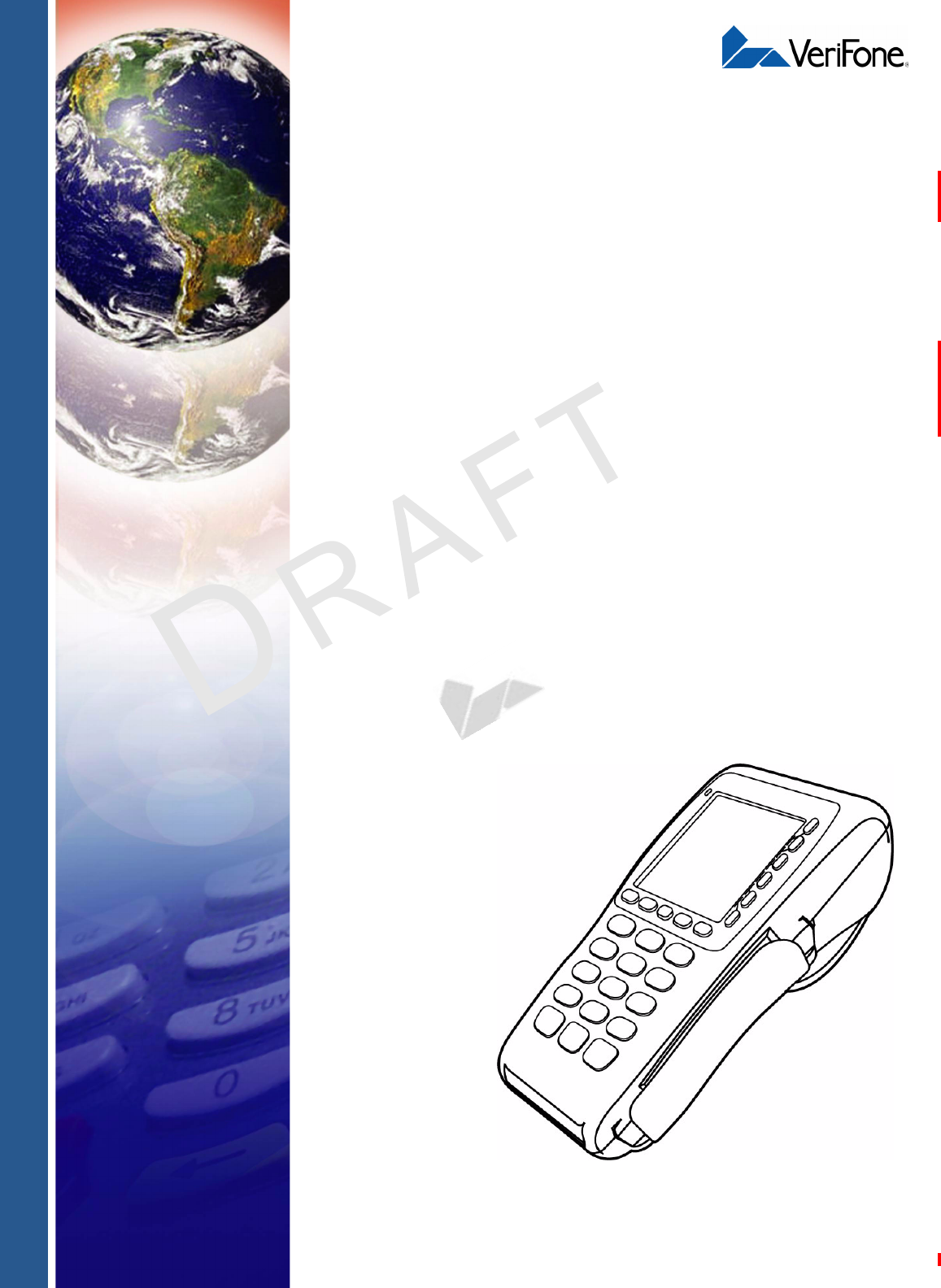
VeriFone Part Number 24003, Revision A.2
TEMPLATE
R
EV
E
Vx670
Installation Guide

All rights reserved. No part of the contents of this document may be reproduced or transmitted in any form without the written
permission of VeriFone, Inc.
The information contained in this document is subject to change without notice. Although VeriFone has attempted to ensure the
accuracy of the contents of this document, this document may include errors or omissions. The examples and sample programs are
for illustration only and may not be suited for your purpose. You should verify the applicability of any example or sample program
before placing the software into productive use. This document, including without limitation the examples and software programs, is
supplied “As-Is.”
VeriFone, Inc.
2099 Gateway Place, Suite 600
San Jose, CA, 95110 USA
www.verifone.com
VeriFone Part Number 24003, Revision A.2
Vx670 Installation Guide
© 2006 VeriFone, Inc.
VeriFone, the VeriFone logo, Omni, VeriCentre, Verix, and ZonTalk are registered trademarks of VeriFone. Other brand names or
trademarks associated with VeriFone’s products and services are trademarks of VeriFone, Inc.
All other brand names and trademarks appearing in this manual are the property of their respective holders.
Comments? Please e-mail all comments on this document to your local VeriFone Support Team.
WARNING
Do not dispose of the Vx670 Li-ion smart battery in a fire. Li-ion batteries must be recycled or
disposed of properly. Do not dispose of Li-ion batteries in municipal waste sites.

VX670 INSTALLATION GUIDE 3
TEMPLATE
R
EV
E
CONTENTS
PREFACE . . . . . . . . . . . . . . . . . . . . . . . . . . . . . . . . . . . . . . . 5
Audience. . . . . . . . . . . . . . . . . . . . . . . . . . . . . . . . . . . . . . . . . . . . . . . . . . . . . . . . 5
Organization . . . . . . . . . . . . . . . . . . . . . . . . . . . . . . . . . . . . . . . . . . . . . . . . . . . . . 5
Related Documentation . . . . . . . . . . . . . . . . . . . . . . . . . . . . . . . . . . . . . . . . . . . . 5
Conventions and Acronyms . . . . . . . . . . . . . . . . . . . . . . . . . . . . . . . . . . . . . . . . . 6
Document Conventions. . . . . . . . . . . . . . . . . . . . . . . . . . . . . . . . . . . . . . . . . . 6
Acronym Definitions . . . . . . . . . . . . . . . . . . . . . . . . . . . . . . . . . . . . . . . . . . . . 6
CHAPTER 1
Terminal Overview Features and Benefits . . . . . . . . . . . . . . . . . . . . . . . . . . . . . . . . . . . . . . . . . . . . 10
Exceptional Ease of Use. . . . . . . . . . . . . . . . . . . . . . . . . . . . . . . . . . . . . . . . 10
Performance and Durability . . . . . . . . . . . . . . . . . . . . . . . . . . . . . . . . . . . . . 10
True Multi-Application Capability . . . . . . . . . . . . . . . . . . . . . . . . . . . . . . . . . 11
Expandable Communication Capabilities . . . . . . . . . . . . . . . . . . . . . . . . . . . 11
Wireless Connectivity . . . . . . . . . . . . . . . . . . . . . . . . . . . . . . . . . . . . . . . . . . 11
Security . . . . . . . . . . . . . . . . . . . . . . . . . . . . . . . . . . . . . . . . . . . . . . . . . . . . . 11
CHAPTER 2
Terminal Setup Select Terminal Location . . . . . . . . . . . . . . . . . . . . . . . . . . . . . . . . . . . . . . . . . . 13
Ease of Use . . . . . . . . . . . . . . . . . . . . . . . . . . . . . . . . . . . . . . . . . . . . . . . . . 13
Environmental Factors . . . . . . . . . . . . . . . . . . . . . . . . . . . . . . . . . . . . . . . . . 14
Electrical Considerations . . . . . . . . . . . . . . . . . . . . . . . . . . . . . . . . . . . . . . . 14
Unpack the Shipping Carton. . . . . . . . . . . . . . . . . . . . . . . . . . . . . . . . . . . . . . . . 14
Examine Terminal Features . . . . . . . . . . . . . . . . . . . . . . . . . . . . . . . . . . . . . . . . 15
Front Panel . . . . . . . . . . . . . . . . . . . . . . . . . . . . . . . . . . . . . . . . . . . . . . . . . . 15
The Handy-Link Connector. . . . . . . . . . . . . . . . . . . . . . . . . . . . . . . . . . . . . . . . . 17
Cable Adapters . . . . . . . . . . . . . . . . . . . . . . . . . . . . . . . . . . . . . . . . . . . . . . . 17
Connection Ports . . . . . . . . . . . . . . . . . . . . . . . . . . . . . . . . . . . . . . . . . . . . . 17
USB Connection . . . . . . . . . . . . . . . . . . . . . . . . . . . . . . . . . . . . . . . . . . . . . . 18
Establish Telephone Line Connections . . . . . . . . . . . . . . . . . . . . . . . . . . . . . . . 19
Install the Paper Roll . . . . . . . . . . . . . . . . . . . . . . . . . . . . . . . . . . . . . . . . . . . . . 20
Install/Replace MSAM Cards . . . . . . . . . . . . . . . . . . . . . . . . . . . . . . . . . . . . . . . 23
Install/Replace SIM Card
(GSM/GPRS Models) . . . . . . . . . . . . . . . . . . . . . . . . . . . . . . . . . . . . . . . . . . . . . 24
Connect the Smart Card Reader (Optional) . . . . . . . . . . . . . . . . . . . . . . . . . . . . 25
Vx670 Smart Card Reader Connection. . . . . . . . . . . . . . . . . . . . . . . . . . . . . 25
Connect the Terminal Power Pack . . . . . . . . . . . . . . . . . . . . . . . . . . . . . . . . . . . 26
Smart Battery . . . . . . . . . . . . . . . . . . . . . . . . . . . . . . . . . . . . . . . . . . . . . . . . . . . 27
Smart Battery Features. . . . . . . . . . . . . . . . . . . . . . . . . . . . . . . . . . . . . . . . . 28
Installation. . . . . . . . . . . . . . . . . . . . . . . . . . . . . . . . . . . . . . . . . . . . . . . . . . . 29
Removal . . . . . . . . . . . . . . . . . . . . . . . . . . . . . . . . . . . . . . . . . . . . . . . . . . . . 29
Charging . . . . . . . . . . . . . . . . . . . . . . . . . . . . . . . . . . . . . . . . . . . . . . . . . . . . 29
Battery Life . . . . . . . . . . . . . . . . . . . . . . . . . . . . . . . . . . . . . . . . . . . . . . . . . . 30
The Vx670 Base Station . . . . . . . . . . . . . . . . . . . . . . . . . . . . . . . . . . . . . . . . . . . 30
Standard Base Station . . . . . . . . . . . . . . . . . . . . . . . . . . . . . . . . . . . . . . . . . 30
Full-featured Base Station . . . . . . . . . . . . . . . . . . . . . . . . . . . . . . . . . . . . . . 31

CONTENTS
4VX670 INSTALLATION GUIDE
TEMPLATE
R
EV
E
Powering up the Base Station. . . . . . . . . . . . . . . . . . . . . . . . . . . . . . . . . . . . 31
Place the Vx670 Terminal Onto the Base Station. . . . . . . . . . . . . . . . . . . . . . . . 32
Attach the USB Dongles to the Base Station . . . . . . . . . . . . . . . . . . . . . . . . . . . 32
Charge the Spare Battery on the Base Station . . . . . . . . . . . . . . . . . . . . . . . . . 33
Wireless Transactions . . . . . . . . . . . . . . . . . . . . . . . . . . . . . . . . . . . . . . . . . . . . 34
Smart Card Transaction . . . . . . . . . . . . . . . . . . . . . . . . . . . . . . . . . . . . . . . . . . . 34
Magnetic Card Reader Use . . . . . . . . . . . . . . . . . . . . . . . . . . . . . . . . . . . . . . . . 35
CHAPTER 3
Specifications Power . . . . . . . . . . . . . . . . . . . . . . . . . . . . . . . . . . . . . . . . . . . . . . . . . . . . . . . . . 37
DC Power Pack . . . . . . . . . . . . . . . . . . . . . . . . . . . . . . . . . . . . . . . . . . . . . . . . . 37
Temperature . . . . . . . . . . . . . . . . . . . . . . . . . . . . . . . . . . . . . . . . . . . . . . . . . . . . 37
Vx670 External Dimensions . . . . . . . . . . . . . . . . . . . . . . . . . . . . . . . . . . . . . . . . 37
Base Station Specifications . . . . . . . . . . . . . . . . . . . . . . . . . . . . . . . . . . . . . . . . 37
CHAPTER 4
Maintenance Clean the Terminal . . . . . . . . . . . . . . . . . . . . . . . . . . . . . . . . . . . . . . . . . . . . . . . 39
Terminal Contacts . . . . . . . . . . . . . . . . . . . . . . . . . . . . . . . . . . . . . . . . . . . . . . . 39
Smart Card Reader . . . . . . . . . . . . . . . . . . . . . . . . . . . . . . . . . . . . . . . . . . . . . . 39
CHAPTER 5
VeriFone Service
and Support
Return a Terminal or Smart Battery for Service . . . . . . . . . . . . . . . . . . . . . . . . . 41
Accessories and Documentation . . . . . . . . . . . . . . . . . . . . . . . . . . . . . . . . . . . . 42
Power Pack. . . . . . . . . . . . . . . . . . . . . . . . . . . . . . . . . . . . . . . . . . . . . . . . . . 42
Thermal Printer Paper. . . . . . . . . . . . . . . . . . . . . . . . . . . . . . . . . . . . . . . . . . 42
VeriFone Cleaning Kit . . . . . . . . . . . . . . . . . . . . . . . . . . . . . . . . . . . . . . . . . . 43
Telephone Line Cord . . . . . . . . . . . . . . . . . . . . . . . . . . . . . . . . . . . . . . . . . . 43
Swivel Stand . . . . . . . . . . . . . . . . . . . . . . . . . . . . . . . . . . . . . . . . . . . . . . . . . 43
Documentation . . . . . . . . . . . . . . . . . . . . . . . . . . . . . . . . . . . . . . . . . . . . . . . 43
CHAPTER 6
Troubleshooting
Guidelines
Terminal Does Not Start . . . . . . . . . . . . . . . . . . . . . . . . . . . . . . . . . . . . . . . . . . . 45
Terminal Display Does not Show Correct/Readable Info . . . . . . . . . . . . . . . . . . 45
Smart Battery Will Not Charge . . . . . . . . . . . . . . . . . . . . . . . . . . . . . . . . . . . . . . 46
Spare Battery in Base Station Will Not Charge . . . . . . . . . . . . . . . . . . . . . . . . . 46
Blank Display . . . . . . . . . . . . . . . . . . . . . . . . . . . . . . . . . . . . . . . . . . . . . . . . . . . 46
Terminal Does Not Dial Out . . . . . . . . . . . . . . . . . . . . . . . . . . . . . . . . . . . . . . . . 46
Printer Does Not Print. . . . . . . . . . . . . . . . . . . . . . . . . . . . . . . . . . . . . . . . . . . . . 46
Printer Paper Jam. . . . . . . . . . . . . . . . . . . . . . . . . . . . . . . . . . . . . . . . . . . . . . . . 47
Peripheral Device Does Not Work . . . . . . . . . . . . . . . . . . . . . . . . . . . . . . . . . . . 47
Keypad Does Not Respond . . . . . . . . . . . . . . . . . . . . . . . . . . . . . . . . . . . . . . . . 47
Transactions Fail To Process . . . . . . . . . . . . . . . . . . . . . . . . . . . . . . . . . . . . . . . 47
INDEX . . . . . . . . . . . . . . . . . . . . . . . . . . . . . . . . . . . . . . . . .49

TEMPLATE
R
EV
E
VX670 INSTALLATION GUIDE 5
PREFACE
This guide is your primary source of information for setting up and installing the
Vx670 terminal.
Audience
This guide is useful for anyone installing and configuring a Vx670 terminal. Basic
descriptions of the terminal features are also provided.
Organization
This guide is organized as follows:
Chapter 1, Terminal Overview. Provides an overview of the Vx670 terminal.
Chapter 2, Terminal Setup. Explains how to set up and install the Vx670 terminal.
It tells you how to select a location, establish power and telephone line
connections, and how to configure optional peripheral devices.
Chapter 3, Specifications. Discusses power requirements and dimensions of the
Vx670 terminal.
Chapter 4, Maintenance. Explains how to maintain your Vx670 terminal.
Chapter 5, VeriFone Service and Support. Provides information on contacting
your local VeriFone representative or service provider, and information on how to
order accessories or documentation from VeriFone.
Chapter 6, Troubleshooting Guidelines. Provides troubleshooting guidelines,
should you encounter a problem in terminal installation and configuration.
Related
Documentation
To learn more about the Vx670 terminal, refer to the following set of documents:
Vx670 Reference Manual VPN XXXXX
Verix V Operating System Programmer’s Manual VPN 23230
Verix V Tools Programmer’s Manual VPN 23231
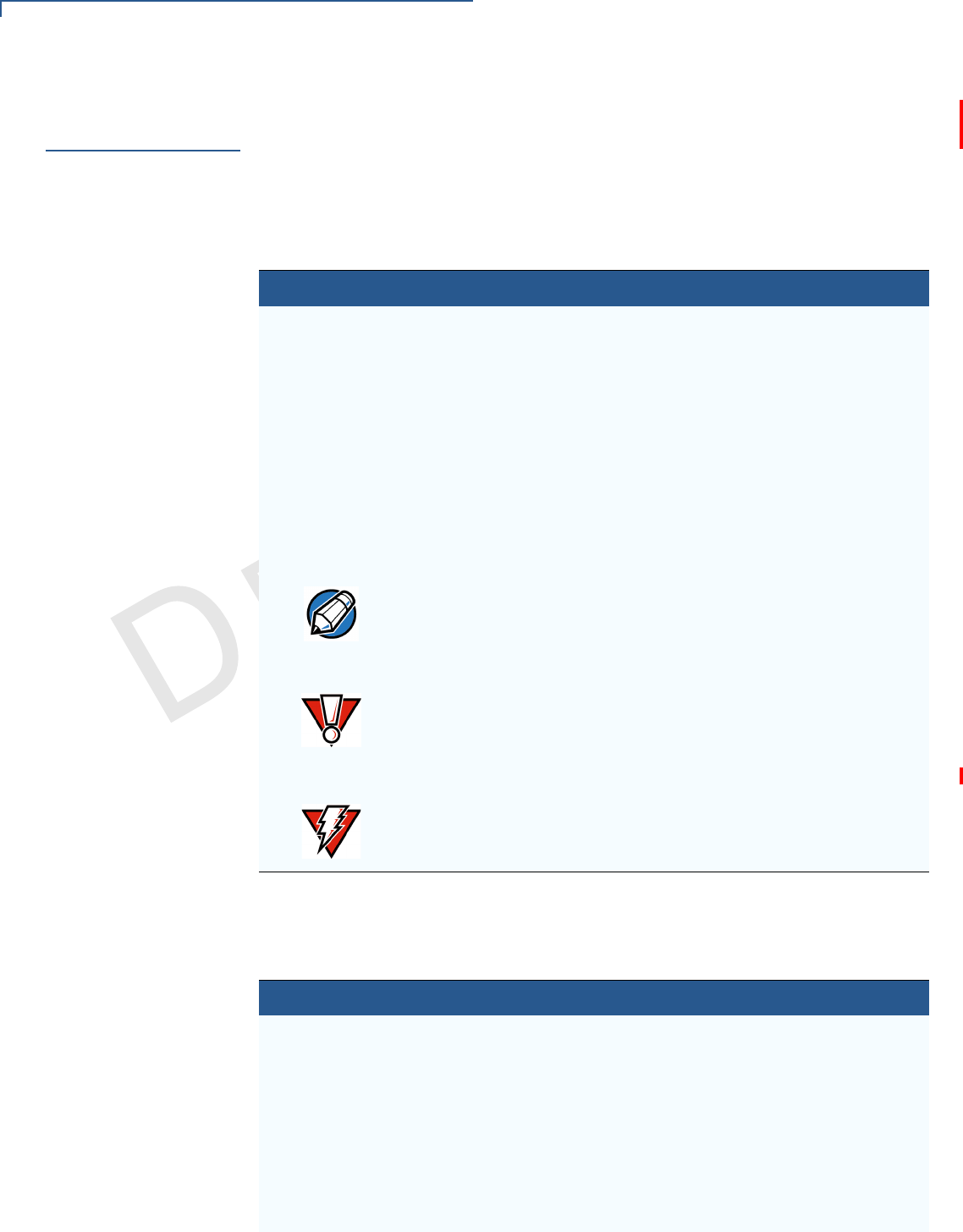
PREFACE
Conventions and Acronyms
6VX670 INSTALLATION GUIDE
TEMPLATE
R
EV
E
Conventions and
Acronyms
This section describes the conventions and acronyms used in this guide.
Document
Conventions
Various conventions are used to help you quickly identify special formatting. Table
1 describes these conventions and provides examples of their use.
Acronym Definitions
Various acronyms are used in place of the full definition. Table 2 presents
acronyms and their definitions.
Table 1 Document Conventions
Convention Meaning Example
Blue Text in blue indicates terms
that are cross referenced.
See Conventions and Acronyms.
Italics Italic typeface indicates
book titles or emphasis.
You must install a roll of thermal-
sensitive paper in the printer.
Courier The courier type face is
used while specifying
onscreen text, such as text
that you would enter at a
command prompt, or to
provide an URL.
http://www.verifone.com
The pencil icon is used to
highlight important
information.
RS-232-type devices do not work
with the PINpad port.
The caution symbol
indicates possible hardware
or software failure, or loss
of data.
The terminal is not waterproof or
dustproof, and is intended for indoor
use only.
The lightning symbol is
used as a warning when
bodily injury might occur.
Due to risk of shock do not use the
terminal near water.
NOTE
CAUTION
WARNING
Table 2 Acronym Definitions
Acronym Definitions
AC Alternating Current
ATM Automated Teller Machine
CDMA Code Division Multiple Access
CR Check Reader
EMV Europay MasterCard and VISA
GPRS General Packet Radio Service
GSM Global System for Mobile Communication
ITP Internal Thermal Printer

PREFACE
Conventions and Acronyms
VX670 INSTALLATION GUIDE 7
TEMPLATE
R
EV
E
LCD Liquid Crystal Display
LED Light Emitting Diode
MRA Merchandise Return Authorization
MSAM Micromodule-Size Security Access Module
PED PIN-Entry Devices
PIN Personal Identification Number
RJ45 Registered Jack 45
RS-232 Recommended Standard 232
SAM Security Access Module
SIM Subscriber Identity Module
UART Universal Asynchronous Transmitter/Receiver
USB Universal Serial Bus
VPN VeriFone Part Number
Wi-Fi Wireless Fidelity
Table 2 Acronym Definitions (continued)
Acronym Definitions

PREFACE
Conventions and Acronyms
8VX670 INSTALLATION GUIDE
TEMPLATE
R
EV
E
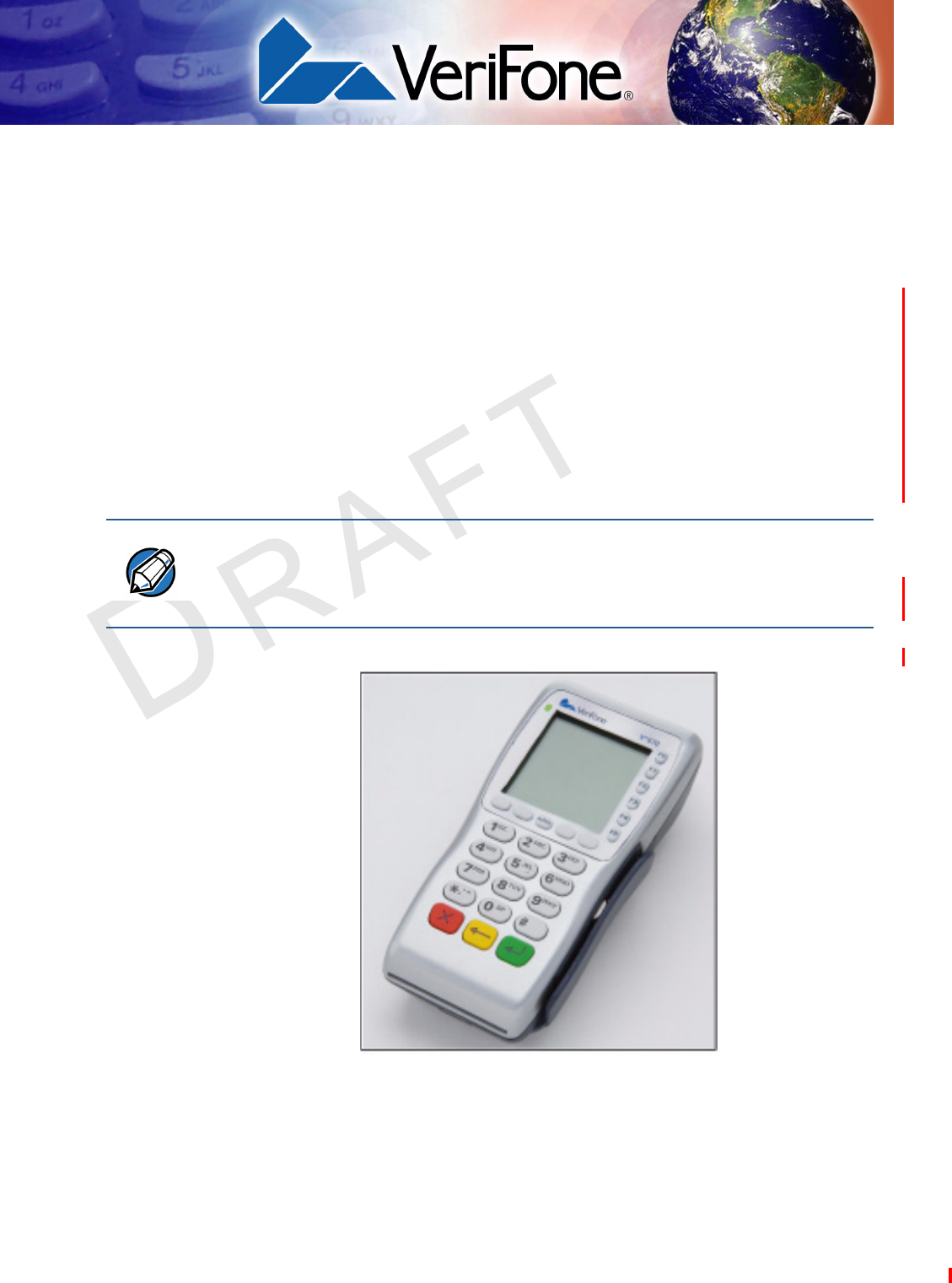
TEMPLATE
R
EV
E
VX670 INSTALLATION GUIDE 9
CHAPTER 1
Terminal Overview
This chapter provides a brief description of the Vx670 terminal. The Vx670
terminal represents the shape of things to come in e-payment. The Vx670 uses a
bold ergonomic design that is sleek and stylish, offering countertop power and 32-
bit performance in an integrated terminal that can be handed to the consumer for
input, making it ideal for pay-at-table usage.
The Vx670 is a portable, battery-powered device that uses wireless technologies,
including Wi-Fi with 802.11g technology and GSM/GPRS. It also features a 128-
by-128 pixel display and a speedy thermal printer.
NOTE VeriFone ships variants of the Vx670 terminal for different markets. Your terminal
may have a different configuration. The following devices may or may not be
present: a smart card reader, zero or three MSAM cardholders, and/or a SIM
cardholder.

TERMINAL OVERVIEW
Features and Benefits
10 VX670 INSTALLATION GUIDE
TEMPLATE
R
EV
E
Features at a glance
Features and
Benefits
Vx670 terminals provide the right combination of features and functions. This
includes a triple-track magnetic-stripe card reader, smart card reader, integrated
PINpad, and a quiet yet fast internal thermal printer (ITP).
Exceptional Ease of
Use
•Lightweight (less than 1 pound), tapered design is compact and stylish and the
ergonomic balance allows for convenient terminal hand-off to the consumer
for PIN entry or other input.
•128-by-128 pixel display with anti-glare, adjustable contrast, dimming
capability, intuitive ATM-style interface, and oversized menu prompts simplify
training and reduce calls to the helpdesk.
•Large, well-placed, blue backlit keys provide improved tactile response to
simplify usage and minimize finger slips.
•Integrated high-speed thermal printer prints quickly and silently, and simplified
paper loading virtually eliminates paper jams.
•Triple-track, high-coercivity card reader handles most magnetic stripe cards.
•Optional Base Station with battery charger supports connectivity to a UART
module or a 1.4.Kbps modem via USB dongles.
•Accepts all types of payments – including debit.
Performance and
Durability
•32-bit processing and multi-tasking capabilities make short work of payment,
payment-related, and value-added applications.
•Exceptional graphics-handling capabilities of display and printer quickly render
logos, graphical fonts, and character-based languages.
•VeriCentre Appliance Management Suite employs advanced file compression
to streamline simultaneous downloads of application software to hundreds of
terminals.
•Rounded corners and drop-resistant design minimizes breakage.
•32-bit ARM9 processor delivers
power and usability in a convenient
“hand-over” design.
•Securely supports and runs payment
and value-added applications.
•Multi-application operating
environment.
•Offers unsurpassed performance on
EMV smart card transactions.
•32-bit processing and multi-tasking
capabilities.
•Security architecture meets
specifications for PCI-PED and
sophisticated file authentication.
•USB support for VeriFone peripheral
devices.
•Max UI design provides large display
on small footprint.
•Backward compatibility with
VeriFone solutions reduces
development costs.
•Designed to meet the needs of
TablePAY, DeliveryPAY, and
CarsidePAY markets.
•Drop resistant design minimizes
breakage.
•Spill resilient design forces liquid
down and off the front of the terminal.

TERMINAL OVERVIEW
Features and Benefits
VX670 INSTALLATION GUIDE 11
TEMPLATE
R
EV
E
•Sealed MSR blade locks out moisture for excellent spill resistance.
•Innovative design protects terminal from spills by forcing liquid down and off
the front of the terminal
•Anti-UV coating prevents terminal casing from becoming brittle and protects
keys from discoloration.
•Integrated PINpad offers added convenience to handle PIN-based
applications.
•Uncompromising reliability from VeriFone, the worldwide leader in
e-payment.
•Complies with RoHS (Restriction of Hazardous Substances) directive of the
European Union.
True Multi-
Application
Capability
•6 MB of memory and the Verix V OS dynamic memory allocation support two
or three typical-sized applications on a single terminal.
•Primary smart card reader and MSAMs safeguard sensitive financial data and
support multiple smart card schemes.
•Vx670 series of terminals and SoftPay EMV software have received EMV
Level 1 and Level 2 Type approval for smart card solutions. Verix EMV Library
provides efficient development of other EMV-compliant applications.
•VeriShield security architecture meets published specifications for PCI-PED
and provides sophisticated file authentication to prevent execution of
unauthorized software on Vx670 terminals.
Expandable
Communication
Capabilities
•USB Host Port
•USB Device Port for application debugging
•RS-232, Serial Port
•14.4Kbps Modem
•Universal Asynchronous Receiver/Transmitter (UART) module
Wireless
Connectivity
•Customers are not tied to a fixed location with the Vx670 wireless terminals –
the point of payment can be almost anywhere.
•“Always-on” wireless connection uses the latest wireless technologies,
including GSM/GPRS and Wi-Fi with 802.11g technology for faster
transmission and enhanced compatibility with access points and routers.
Security
•WPA-PSK (pre-shared keys) protects Wi-Fi transactions.
•Other security features include tamper-resistant construction, adoption of SSL
protocols, and VeriShield file authentication.

TERMINAL OVERVIEW
Features and Benefits
12 VX670 INSTALLATION GUIDE
TEMPLATE
R
EV
E

TEMPLATE
R
EV
E
VX670 INSTALLATION GUIDE 13
CHAPTER 2
Terminal Setup
This chapter describes the terminal setup procedure. You will learn how to:
•Select Terminal Location and Protect the Terminal From Adverse
Environmental Factors.
•Unpack the Shipping Carton.
•Examine Terminal Features.
•Examine The Handy-Link Connector.
•Establish Telephone Line Connections.
•Install the Paper Roll in the Printer.
•Install/Replace MSAM Cards.
•Install/Replace SIM Card (GSM/GPRS Models).
•Connect the Smart Card Reader (Optional).
•Connect the Terminal Power Pack.
•Use and charge the Smart Battery.
•Use the The Vx670 Base Station.
•Place the Vx670 Terminal Onto the Base Station.
•Attach the USB Dongles to the Base Station.
•Charge the Spare Battery on the Base Station.
•Conduct Wireless Transactions.
•Conduct Smart Card or Credit/Debit Transactions. See Smart Card
Transaction and Magnetic Card Reader Use.
Select Terminal
Location
Use the following guidelines when selecting a location for your Vx670 terminal.
Ease of Use
•Select a location convenient for both merchant and cardholder.
•Select a flat support surface, such as a countertop or table.
•Select a location near a power outlet and a telephone/modem line connection.
For safety, do not string the power cord in a walkway or place it across a
walkway on the floor.

TERMINAL SETUP
Unpack the Shipping Carton
14 VX670 INSTALLATION GUIDE
TEMPLATE
R
EV
E
Environmental
Factors
•Do not use the terminal where there is high heat, dust, humidity, moisture, or
caustic chemicals or oils.
•Keep the terminal away from direct sunlight and anything that radiates heat,
such as a stove or motor.
•Do not use the terminal outdoors.
Electrical
Considerations
•Avoid using this product during electrical storms.
•Avoid locations near electrical appliances or other devices that cause
excessive voltage fluctuations or emit electrical noise (for example, air
conditioners, electric motors, neon signs, high-frequency or magnetic security
devices, or computer equipment).
•Do not use the terminal near water or in moist conditions.
Unpack the
Shipping Carton
Open the shipping carton and carefully inspect its contents for possible tampering
or shipping damage. The Vx670 is a secure product and any tampering may
cause the terminal to cease to function properly.
To unpack the
Shipping Carton
1Remove and inspect the following items:
•Terminal
•Power pack
•Telephone line cord
•Power cord
•Battery pack
•Handy-Link connector
•Paper roll
•USB Dongle - Modem
•USB Dongle - Serial
•Base Station
•Cable adapters
(need additional info regarding list above)
2Remove all plastic wrapping from the terminal and other components.
CAUTION The terminal is not waterproof or dustproof, and is intended for indoor use only.
Any damage to the unit from exposure to rain or dust may void any warranty.
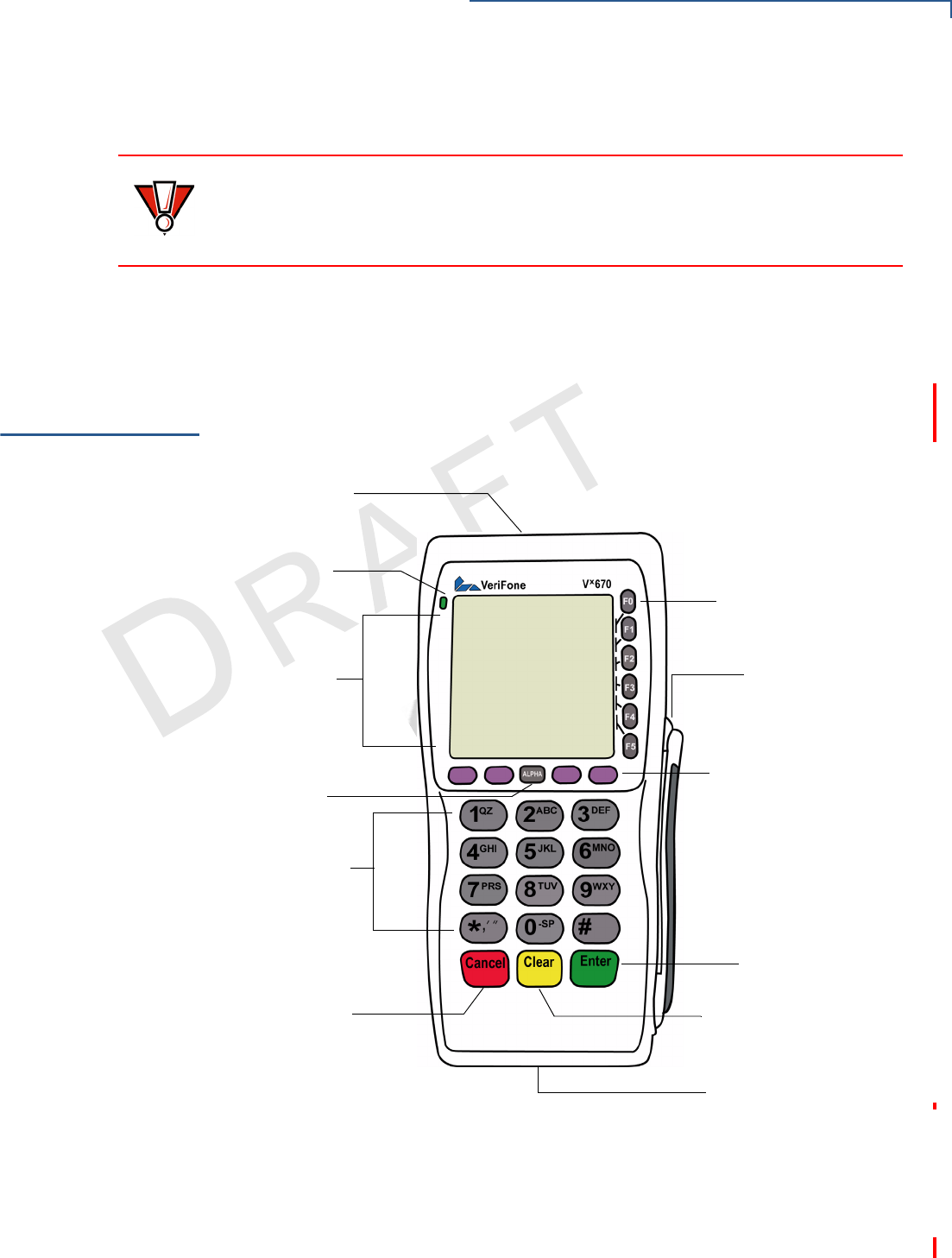
TERMINAL SETUP
Examine Terminal Features
VX670 INSTALLATION GUIDE 15
TEMPLATE
R
EV
E
3Remove the clear protective film from the LCD screen.
4Save the shipping carton and packing material for future repacking or moving
the terminal.
Examine
Terminal
Features
Before you continue the installation process, notice the features of the
Vx670 terminal (see Figure 1).
Figure 1 Vx670 Terminal Features (Front Panel)
Front Panel
The front panel includes the following features:
•A terminal display, backlit LCD screen.
•Five types of keys:
aA 12-key, telephone-style keypad.
CAUTION Do not use a terminal that has been damaged or tampered with. The
Vx670 terminal comes equipped with tamper-evident labels. If a label or
component appears damaged, please notify the shipping company and your
VeriFone representative or service provider immediately.
TERMINAL DISPLAY
MAGNETIC CARD
TELEPHONE-STYLE
KEYPAD
CANCEL KEY CLEAR KEY
ENTER KEY
PROGRAMMABLE
ATM-STYLE FUNCTION
ALPHA KEY
SMART CARD READER
INDICATOR LED
INTERNAL THERMAL
PRINTER (AT THE BACK)
FUNCTION KEYS
KEYS
READER

TERMINAL SETUP
Examine Terminal Features
16 VX670 INSTALLATION GUIDE
TEMPLATE
R
EV
E
bSix ATM-style function keys, labeled F0 to F5, to the right of the LCD
screen.
cFour unlabeled, programmable function keys above the keypad.
dThree color-coded function keys below the
keypad (icons at right; from left to right: CANCEL,
CLEAR, ENTER).
eAn ALPHA key centered at the top of the keypad.
•A magnetic card reader, built into the right side. The icon at right
shows the proper swipe direction, with the stripe down and facing
inward, toward the keypad. (need to verify if magnetic card reader
icon is on Vx670)
•A green indicator LED indicates power is ON.
•An internal thermal printer at the back of the terminal.
•A smart card reader, built into the front of the terminal. The icon
shown at right indicates proper card position and insertion
direction.
•A SAM (security access module) compartment, built into the bottom of the
terminal. The Vx670 terminal contains MSAM cardholders to support multiple
stored-value card programs or other merchant card requirements.
NOTE VeriFone ships variants of the Vx670 terminal for different markets. Your terminal
may have a different configuration. The following devices may or may not be
present: a smart card reader, or zero or three MSAM cardholders. However, the
basic processes described in this guide remain the same, regardless of terminal
configuration.
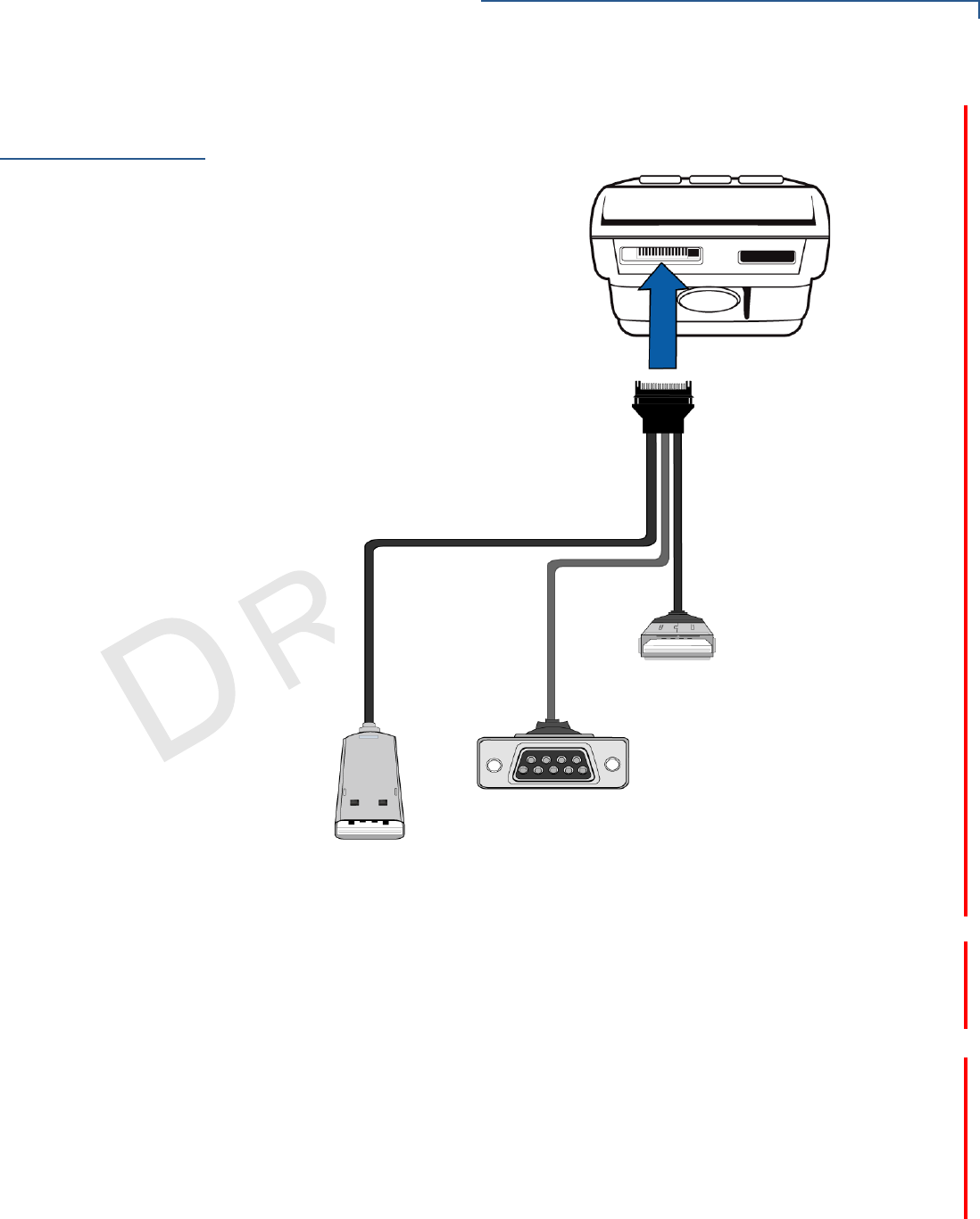
TERMINAL SETUP
The Handy-Link Connector
VX670 INSTALLATION GUIDE 17
TEMPLATE
R
EV
E
The Handy-Link
Connector
The Handy-Link connector is a cell phone style connector that supports a wide
variety of communication ports via cable adapters.
Figure 2 The Vx670 Handy-Link Connector
Cable Adapters
cThe cable adapters enable the Vx670 terminal to connect to .....
(need content and images of cable adapters for this section, or are these the
same as the ports shown above?)
Connection Ports
The Vx670 has one primary port that uses the Handy-Link connector to support
the following peripherals through the use of cable adapters:
Serial Port (COM 1)
A 4-Wire RS232 port with TX, RX, RTS, and CTS signals. This port will provide for
“back-to-back” download capability.
USB HOST
SERIAL PORT (COM 1)
USB DEVICE
CELL PHONE STYLE
CONNECTOR
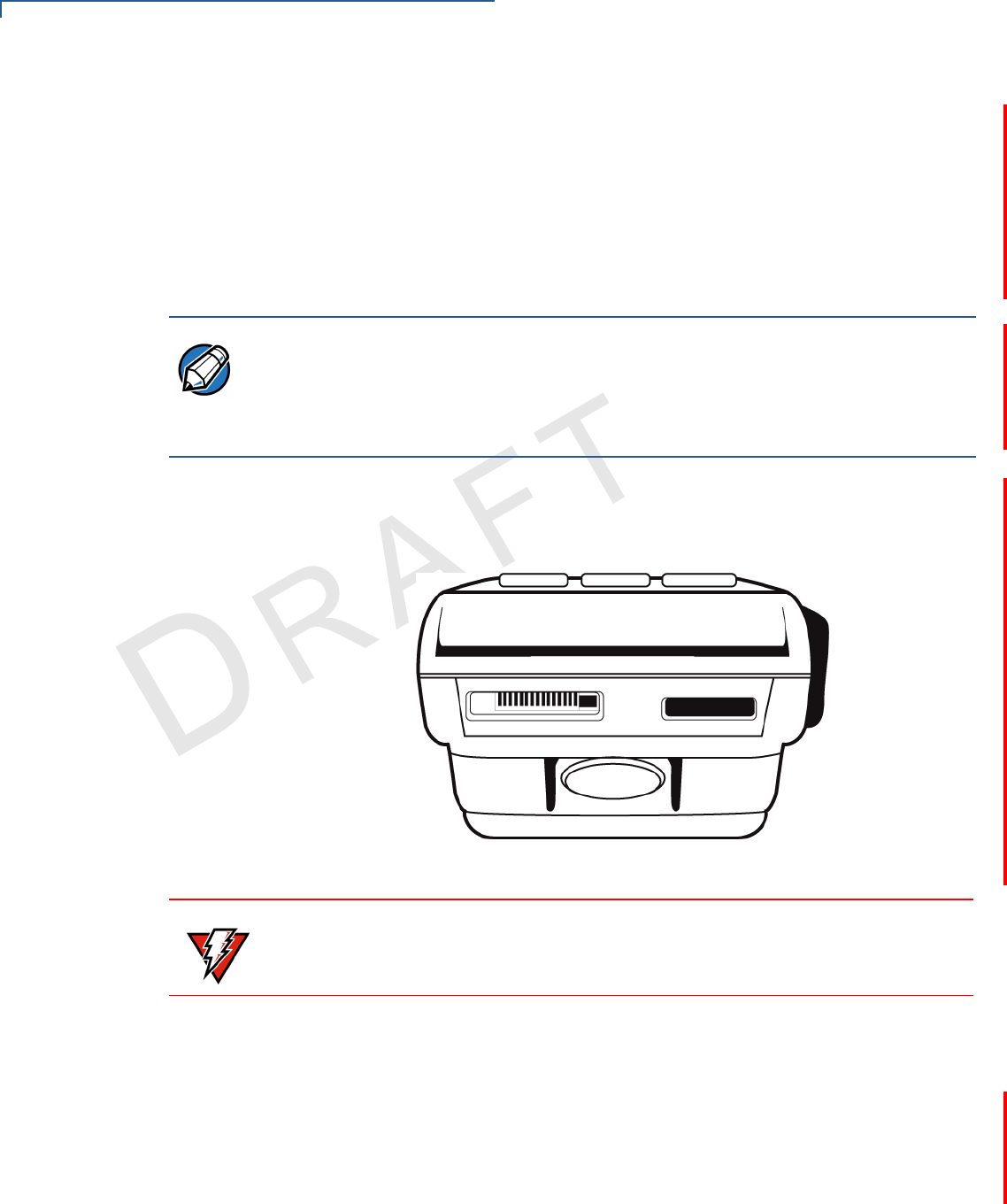
TERMINAL SETUP
The Handy-Link Connector
18 VX670 INSTALLATION GUIDE
TEMPLATE
R
EV
E
USB Host
A 2-Wire USB Host port for external peripherals. A connector adaptor provides for
standard USB host connection.
USB Device
A 2-Wire USB device port connected directly to the PC’s USB ports. This port is
mainly for debugging purposes.
Turn the terminal upside down to view the Vx670’s primary port. Figure 3 shows
the primary port for the Vx670 terminal.
Figure 3 The Vx670 Primary Port (Bottom View)
For information on how to attach peripheral devices, see Connect the Smart Card
Reader (Optional).
USB Connection
Aside from the Handy-Link connector that connects to the primary port, the Vx670
has a USB port that supports a modem or an RJ45 connector.
(need more info and new images for this section; is this the same as the USB port
attached to the Handy-Link cable?)
NOTE A Base Station is also provided with the Vx670. A full-feature Base Station has
two USB host ports for external dongles as well as a battery charger slot for
charging an extra lithium-ion battery pack. A standard Base Station does not have
any USB ports and is capable of charging the terminal only and not the extra
battery pack.
WARNING Do not connect the terminal to the power supply until all the peripherals are
attached.
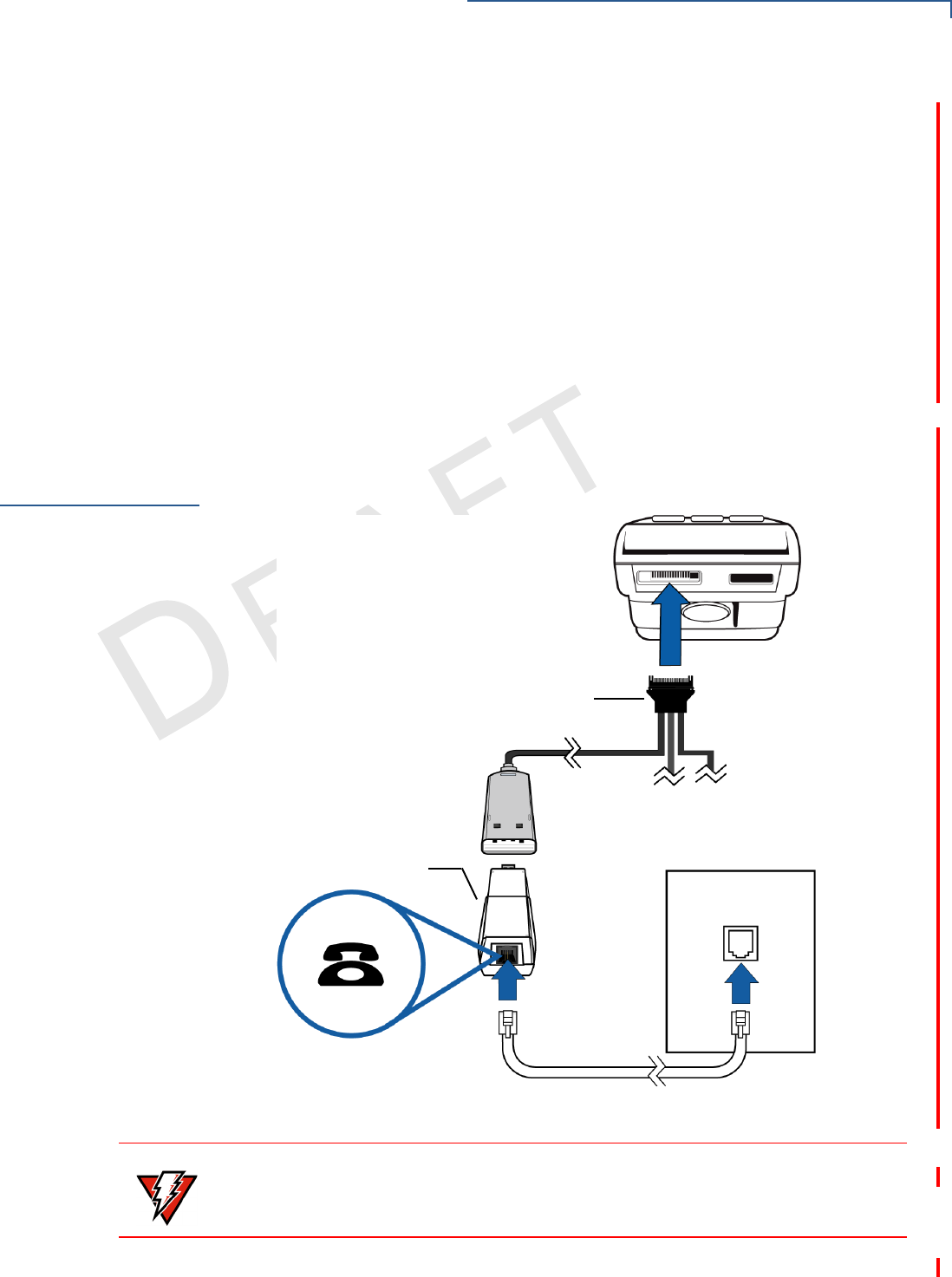
TERMINAL SETUP
Establish Telephone Line Connections
VX670 INSTALLATION GUIDE 19
TEMPLATE
R
EV
E
USB Dongle – Modem
A modem in the form of a USB dongle is provided with the Vx670 terminal. The
USB Dongle – Modem provides communication via a telephone line at speeds of
up to 14.4Kbps. The USB Dongle – Modem can also be connected to the full-
feature Base Station when the terminal is in the station.
USB Dongle – Serial
The USB Dongle – Serial provides the Vx670 terminal with a serial communication
port for backward compatibility. It is designed to accommodate the RJ45
connector. The USB Dongle - Serial can also be connected to the full-feature
Base Station when the terminal is placed in the station.
Establish
Telephone Line
Connections
Connect the USB Dongle – Modem to the USB port of the Handy-Link connector,
which is connected to the Vx670 terminal. Connect the telephone cord to the
modem, then route the other end directly to a telephone wall jack (see Figure 4).
Figure 4 Vx670 Telephone Connection Via Modem
(are we going to remove the USB port on top of current prototypes?)
USB DONGLE - MODEM
USB PORT
HANDY-LINK CONNECTOR
WARNING To reduce the risk of fire, use only No. 26 AWG or larger telecommunication line
cord.
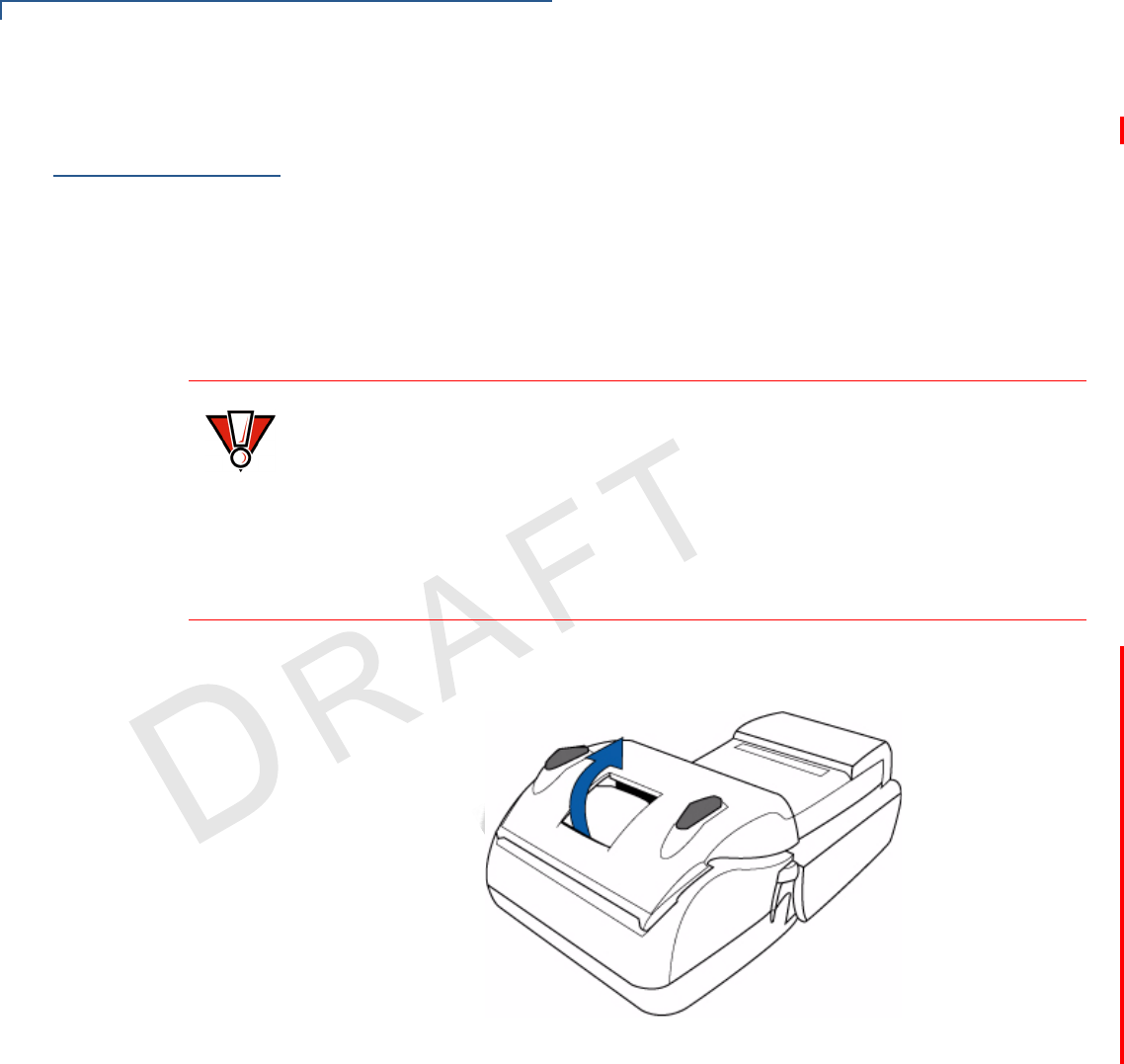
TERMINAL SETUP
Install the Paper Roll
20 VX670 INSTALLATION GUIDE
TEMPLATE
R
EV
E
Install the Paper
Roll
A fast, quiet thermal printer is built into the Vx670 terminal. Before you can
process transactions that require a receipt or record, you must install a roll of
thermal-sensitive paper in the printer.
The ITP uses a roll of single-ply, thermal-sensitive paper 57 millimeters (2.24
inches) wide and 25 meters (82 feet) long. A pink out-of-paper indicator line
appears on the edge of the paper approximately 18 inches before the end of the
roll. After this line appears, there is enough paper remaining on the roll to
conclude at least one transaction.
To Install a Paper Roll 1Gently pull the latch located on the bottom of the terminal to unlock the paper
roll cover.
Figure 5 Unlocking the Printer Cover
CAUTION Poor-quality paper can jam the printer and create excessive paper dust. To order
high-quality VeriFone paper, refer to Accessories and Documentation.
Store thermal paper in a dry, dark area. Handle thermal paper carefully: impact,
friction, temperature, humidity, and oils affect the color and storage
characteristics of the paper.
Never load a roll of paper with folds, wrinkles, tears, or holes at the edges in the
print area.
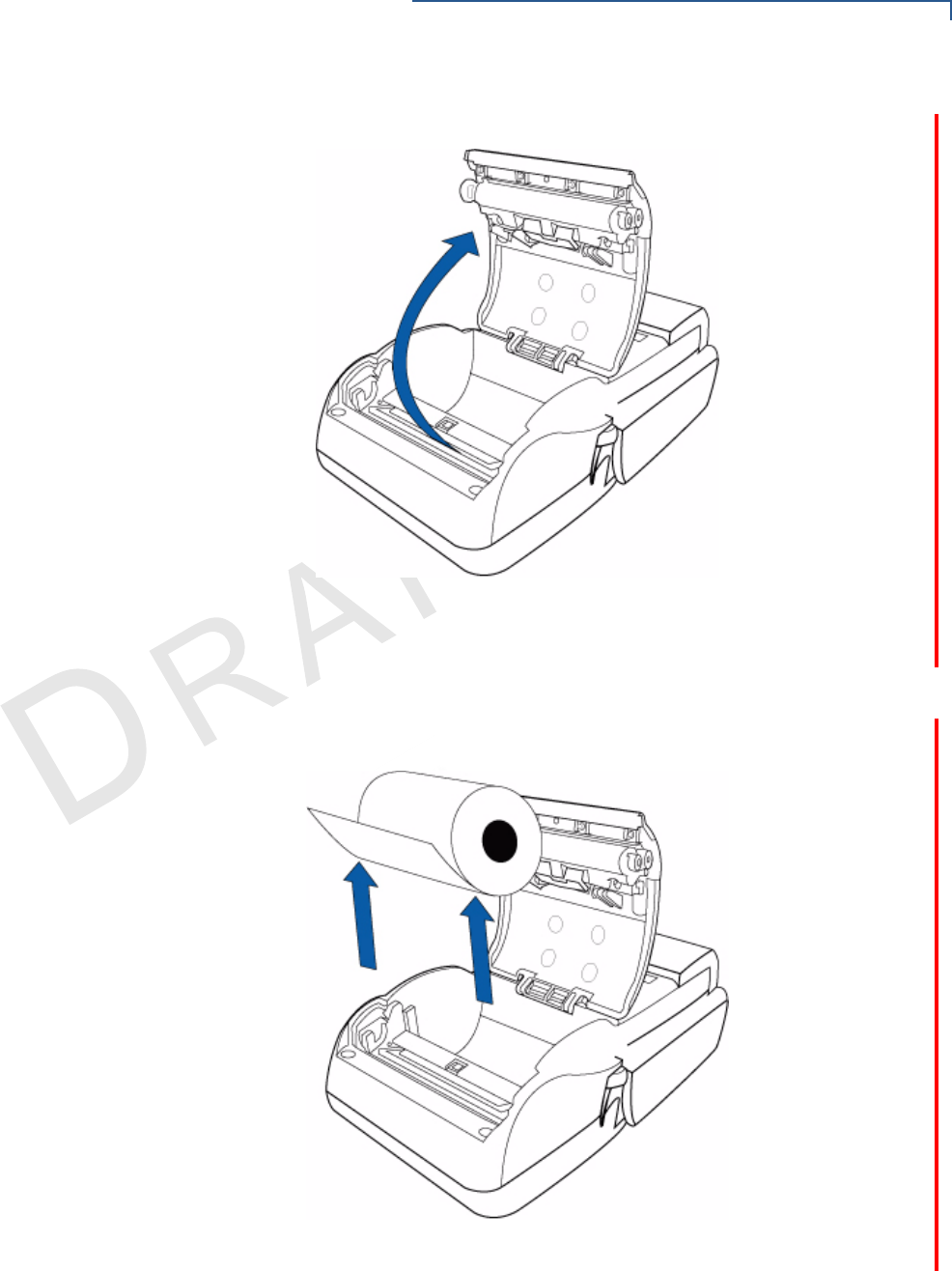
TERMINAL SETUP
Install the Paper Roll
VX670 INSTALLATION GUIDE 21
TEMPLATE
R
EV
E
2Lift the printer cover up and back.
Figure 6 Opening the Printer Cover
3Remove any partial roll of paper in the printer tray by lifting it up (see Figure 7).
4Loosen the glued leading edge of the paper or remove the protective strip
from the new roll of paper. Unwind the paper roll past any glue residue.
Figure 7 Removing Partial Paper Roll
5Hold the roll so the paper feeds from the bottom of the roll (see Figure 9).
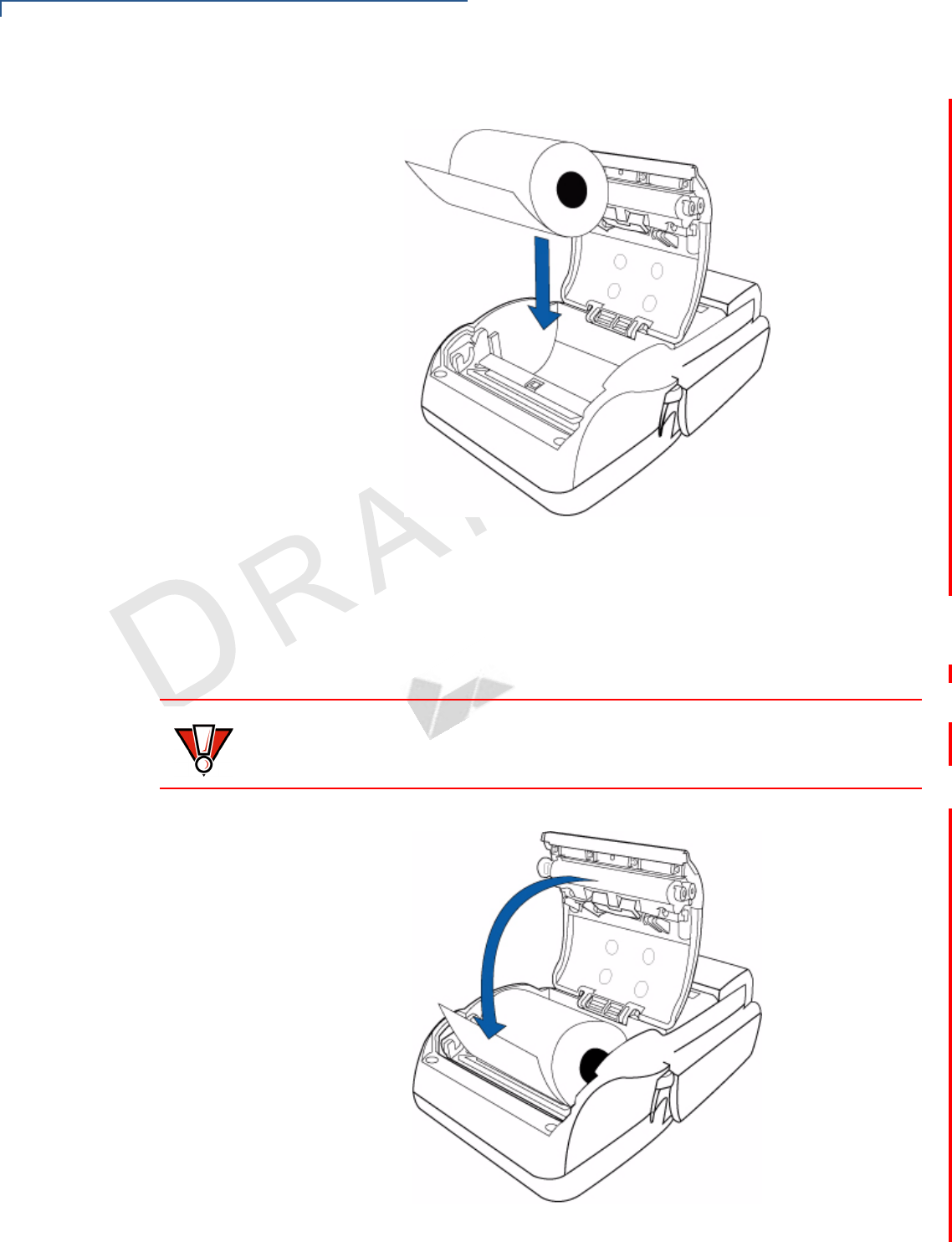
TERMINAL SETUP
Install the Paper Roll
22 VX670 INSTALLATION GUIDE
TEMPLATE
R
EV
E
6Drop the paper roll into the printer tray.
Figure 8 Loading Paper Roll
7Pull paper up past the glue residue from the printer tray.
8Close the paper roll cover by gently pressing directly on the cover until it clicks
shut, allowing a small amount of paper past the glue residue to extend outside
the printer door.
Figure 9 Closing Paper Roll Cover
CAUTION To prevent damaging the print roller, always gently press down on the paper roll
cover to close it.
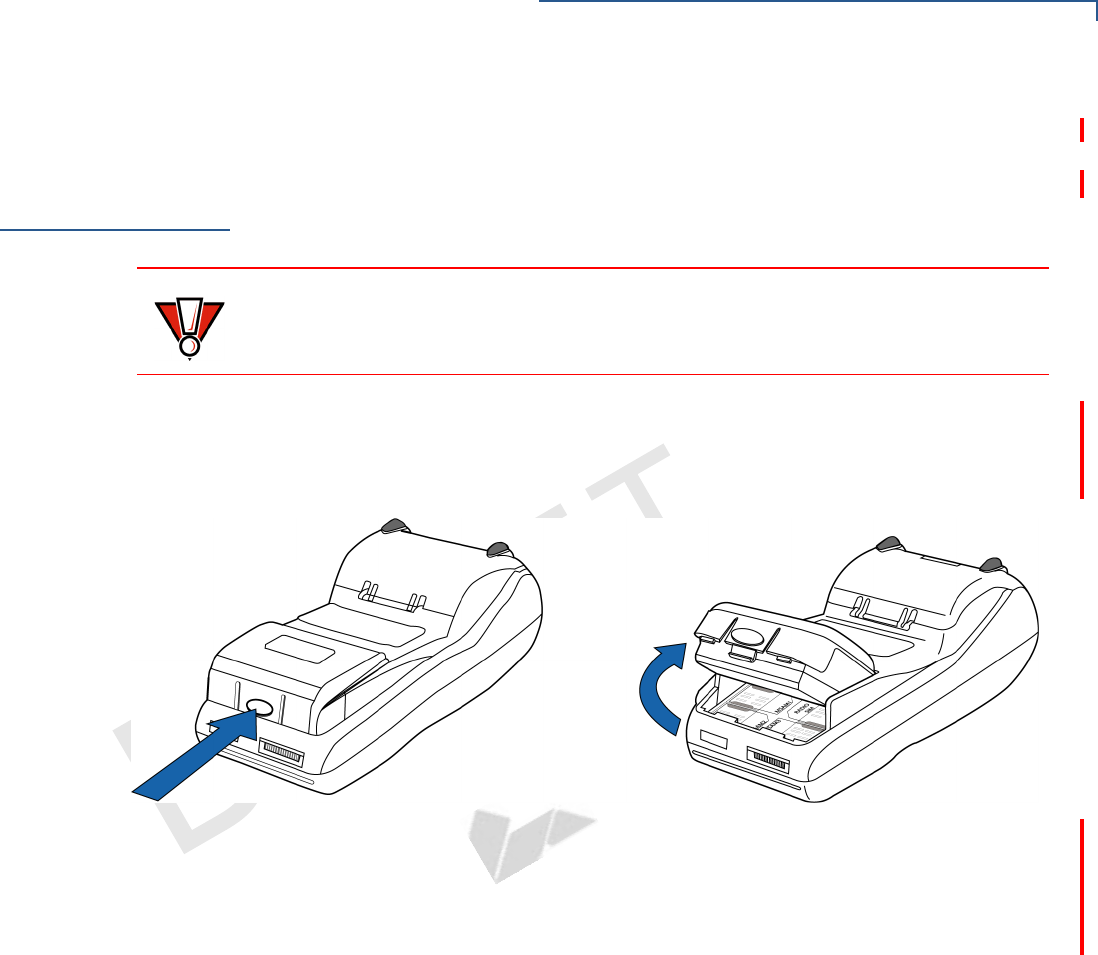
TERMINAL SETUP
Install/Replace MSAM Cards
VX670 INSTALLATION GUIDE 23
TEMPLATE
R
EV
E
9Tear the paper off against the serrated plastic strip in the printer.
Install/Replace
MSAM Cards
When you first receive your Vx670 terminal, you may need to install one or more
MSAM cards or you may need to replace old cards.
To Install/Replace
MSAMs
1Place the terminal upside down on a soft, clean surface to protect the lens
from scratches.
2Remove the battery.
Figure 10 Removing the Smart Battery
3After removing the battery, the MSAM compartments are exposed.
4Remove any previously installed MSAM card by sliding the card from the
MSAM cardholder.
CAUTION Observe standard precautions when handling electrostatically sensitive devices.
Electrostatic discharges can damage this equipment. VeriFone recommends
using a grounded anti-static wrist strap.
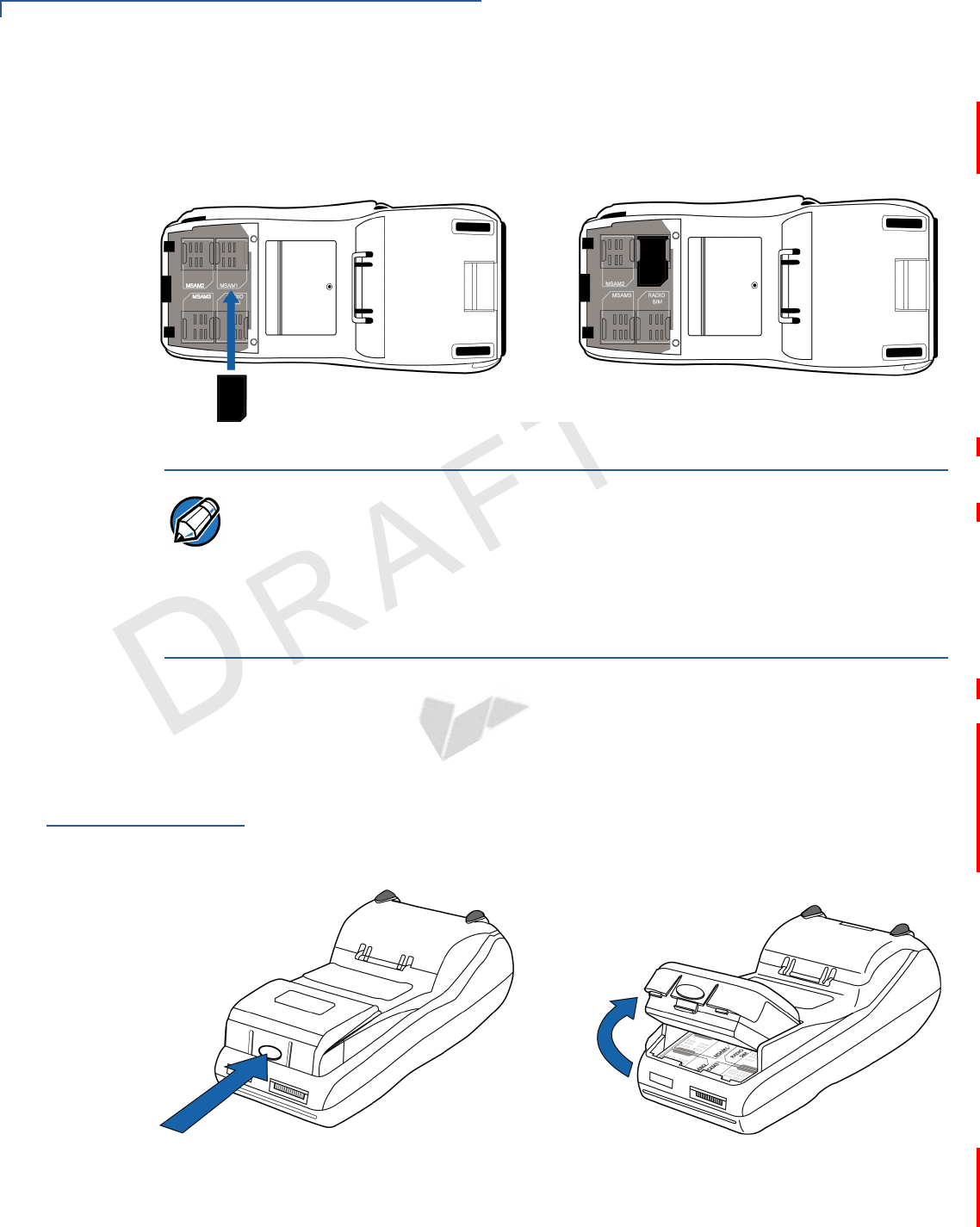
TERMINAL SETUP
Install/Replace SIM Card (GSM/GPRS Models)
24 VX670 INSTALLATION GUIDE
TEMPLATE
R
EV
E
5Install an MSAM card by aligning the card and carefully sliding it within the
guides on the cover until it is fully inserted (see Figure 11). The MSAM card
holders are labeled MSAM1, MSAM2, and MSAM3.
Figure 11 Installing MSAM Card
6Install the battery (see Figure 16).
Install/Replace
SIM Card
(GSM/GPRS
Models)
The Vx670 terminal supports the installation of a SIM (Subscriber Identity Module)
card. Use the following procedure to replace or install a SIM card.
1Place the terminal upside down on a soft, clean surface to protect the lens
from scratches.
2Remove the battery.
Figure 12 Removing the Smart Battery
3After removing the battery, the SIM compartment is exposed. The SIM card
holder is labeled RADIO SIM.
NOTE Before inserting the MSAM card, position it as shown in Figure 11, with the card’s
gold contacts facing the smart card reader end of the terminal. The cardholder
connector base has a set of contacts and a notch on one corner to ensure the
MSAM card is positioned correctly. The MSAM card has a notch on one corner to
ensure that it fits into the connector base in only one way. The MSAM
compartment door will not close properly if the MSAM cards are installed
incorrectly.
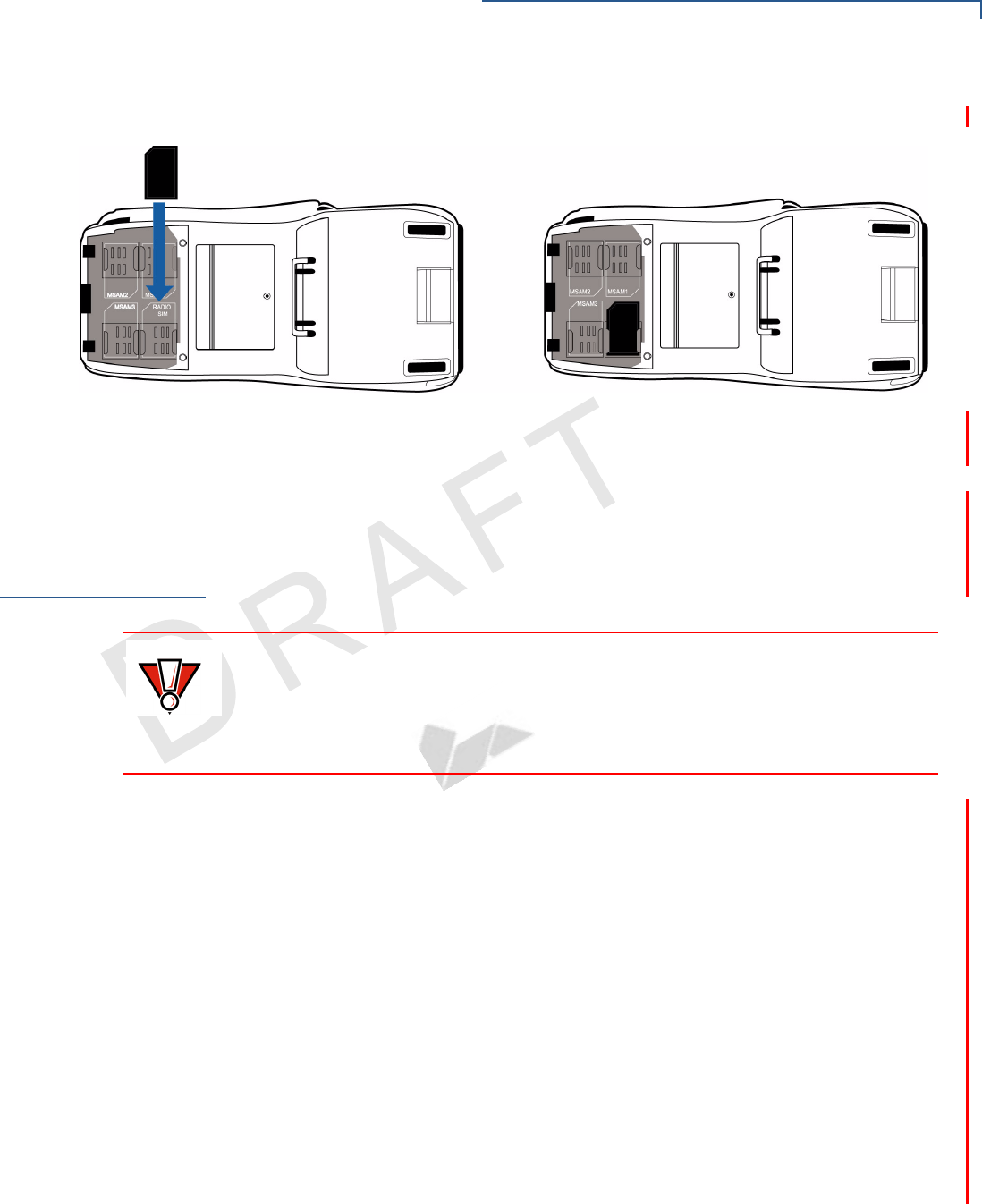
TERMINAL SETUP
Connect the Smart Card Reader (Optional)
VX670 INSTALLATION GUIDE 25
TEMPLATE
R
EV
E
4Insert the SIM into the cardholder.
Figure 13 Inserting SIM Card
5Install the battery (see Figure 16).
Connect the
Smart Card
Reader
(Optional)
The Vx670 supports the connection of an external smart card reader.
Different terminals support different devices. For more information about optional
devices, please contact your VeriFone distributor.
V
x
670 Smart Card
Reader Connection
The Vx670 supports external smart card readers via the USB Dongle - Serial
connected to the USB port of the terminal.
(not sure if this section should be deleted. what exactly is the use of the USB
Dongle - Serial? is this different from the RS232 port?)
Connecting the Smart Card Reader to the Vx670
Use the following procedure to connect a smart card reader.
1Connect the RS232 module (USB dongle) to the USB port of the Handy-Link
connector, which is connected to the primary port of the Vx670 terminal. (need
more info about this procedure)
2Insert the RJ45-type connector on the end of the smart card reader into the
RS232 port.
If a cable is not connected to the smart card reader, insert the small modular
plug on one end of the interface cable into the optional device’s modular jack.
CAUTION Before connecting any peripheral device, remove the power cord from the bottom
of the terminal and ensure that the green indicator LED is not lit. Reconnect the
power cord only after you are finished connecting the peripheral device(s). For
complete information about peripheral installation and use, refer to the user
documentation supplied with those devices.
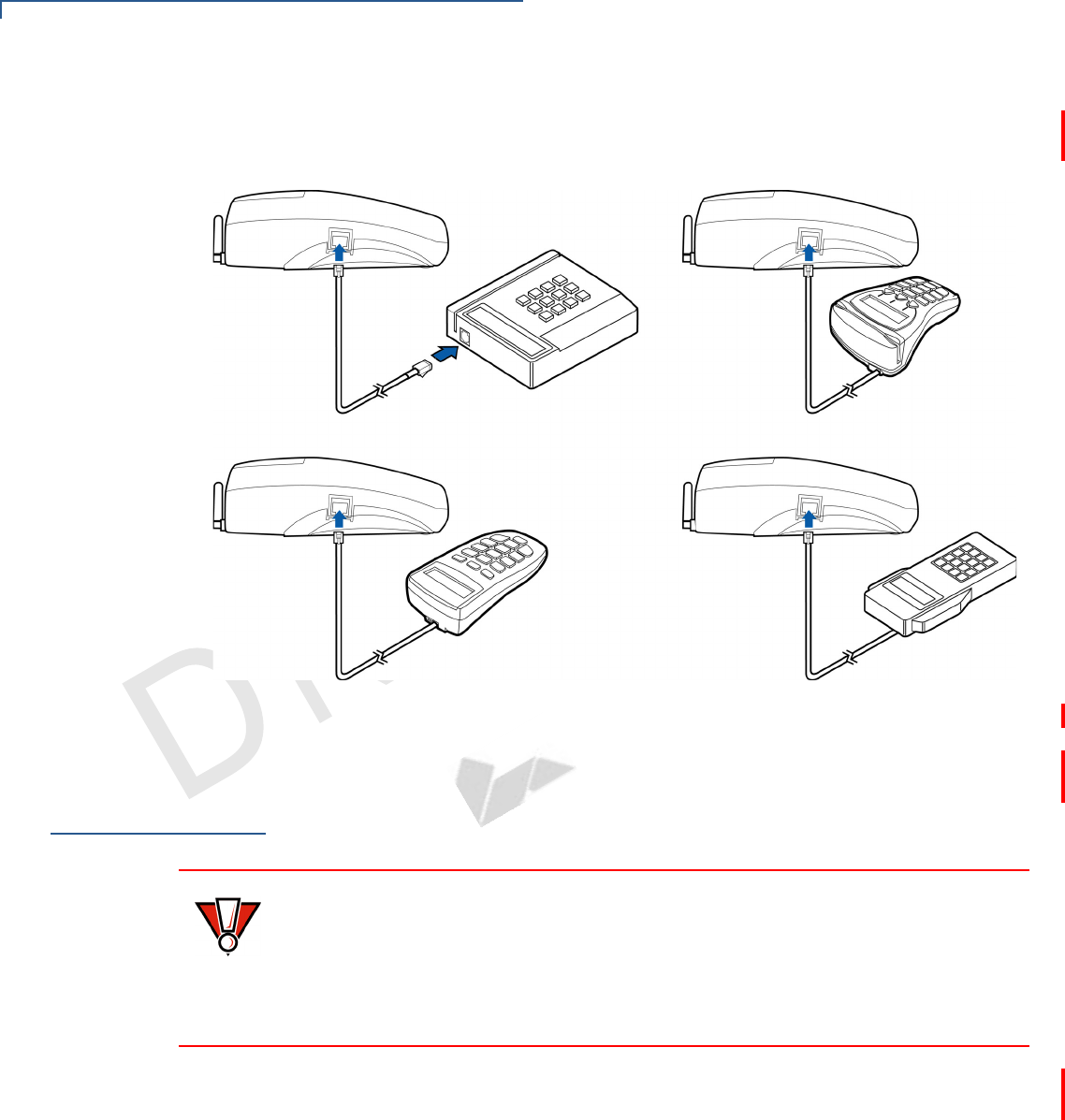
TERMINAL SETUP
Connect the Terminal Power Pack
26 VX670 INSTALLATION GUIDE
TEMPLATE
R
EV
E
3Figure 14 provides an example of a smart card reader to the RS232 port.
(need new image for this)
Figure 14 Vx670 Example Smart Card Reader Connection
Connect the
Terminal Power
Pack
When you have finished connecting optional peripheral(s), you are ready to
connect the Vx670 terminal to the provided power source.
The Vx670 comes with a universal input power pack capable of operating from
voltages of 100VAC to 240VAC.
CAUTION Using an incorrectly rated power supply may damage the terminal or cause it not
to work as specified. Before troubleshooting, ensure that the power supply being
used to power the terminal matches the requirements specified on the bottom of
the terminal. (See Chapter 3, Specifications, for detailed power supply
specifications.) Obtain the appropriately rated power supply before continuing
with troubleshooting.
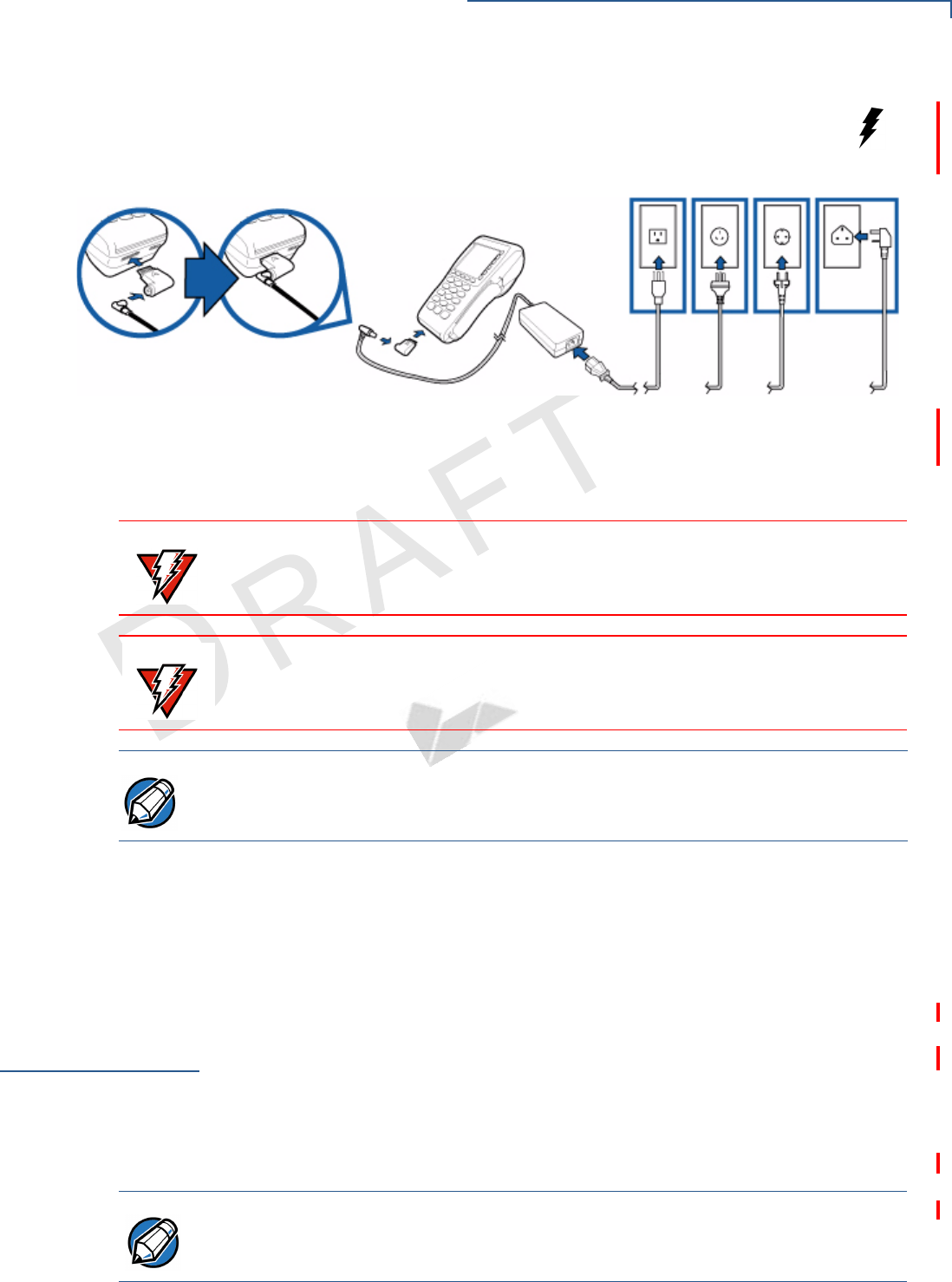
TERMINAL SETUP
Smart Battery
VX670 INSTALLATION GUIDE 27
TEMPLATE
R
EV
E
To Connect the
Terminal Power Pack
1Insert the round barrel connector into the power port in the Handy-
Link connector, identified by the icon at right.
(need to updated this image after QIG is updated)
Figure 15 Vx670 Power Pack Connection
2Insert the AC power cord into the power pack.
3Plug the AC power cord into a wall outlet or powered surge protector.
When the terminal has power, the terminal lights are activated and the green LED
indicator remains lit.
If an application is loaded in the terminal, it starts after the initial VeriFone
copyright screen and usually displays a unique copyright screen. If no application
is loaded in the terminal, DOWNLOAD NEEDED appears on screen after the initial
VeriFone copyright screen.
Smart Battery
The Vx670 terminal uses an Li-ion smart battery (see Accessories and
Documentation for ordering information). The internal logic of the smart battery
prevents both overcharging and undercharging (a fault condition in which the
battery level goes well below the minimum acceptable charge and the battery
becomes unusable).
WARNING Do not plug the power pack into an outdoor outlet or operate the terminal
outdoors.
WARNING Disconnecting the power during a transaction may cause transaction data files
not yet stored in terminal memory to be lost.
NOTE To protect against possible damage caused by lightning strikes and electrical
surges, consider installing a power surge protector.
NOTE The Vx670 terminal will operate on battery power or on power pack power. The
smart battery charger in the terminal will be active whenever the power pack is
connected.

TERMINAL SETUP
Smart Battery
28 VX670 INSTALLATION GUIDE
TEMPLATE
R
EV
E
The Vx670 comes with two types of battery packs, the standard battery pack and
the high-capacity battery pack.
Standard Battery Pack
The standard battery has a capacity of 1250mAh. It is suited for WiFi and pay-at-
table applications where frequent charging is required.
High-Capacity Battery Pack
The high-capacity battery pack is bigger than the standard battery pack and is
more suitable for GPRS/CDMA applications.
Smart Battery
Features
The following are features of the smart battery:
•Two Li-ion cells
•A fuel gauge module that
•monitors state of charge (voltage and current),
•communicates with the terminal (charge parameters and status to indicate
full discharge),
•determines full charge capacity (on charge cycle and uninterrupted
discharge cycle), and
•automatically shuts down when cell voltage is extremely low.
•A safety circuit that
•prevents cell damage from overcharge, over-discharge, or overheating
•activates when the battery is left in an unused terminal for extended
periods, and
•resets when battery voltage reaches a preset threshold during the charge
cycle.
NOTE Conserve battery power by turning the Vx670 terminal off when not in use. If the
terminal is not to be used for several days, remove the battery from the terminal
as it continues to discharge even when the terminal is turned off.
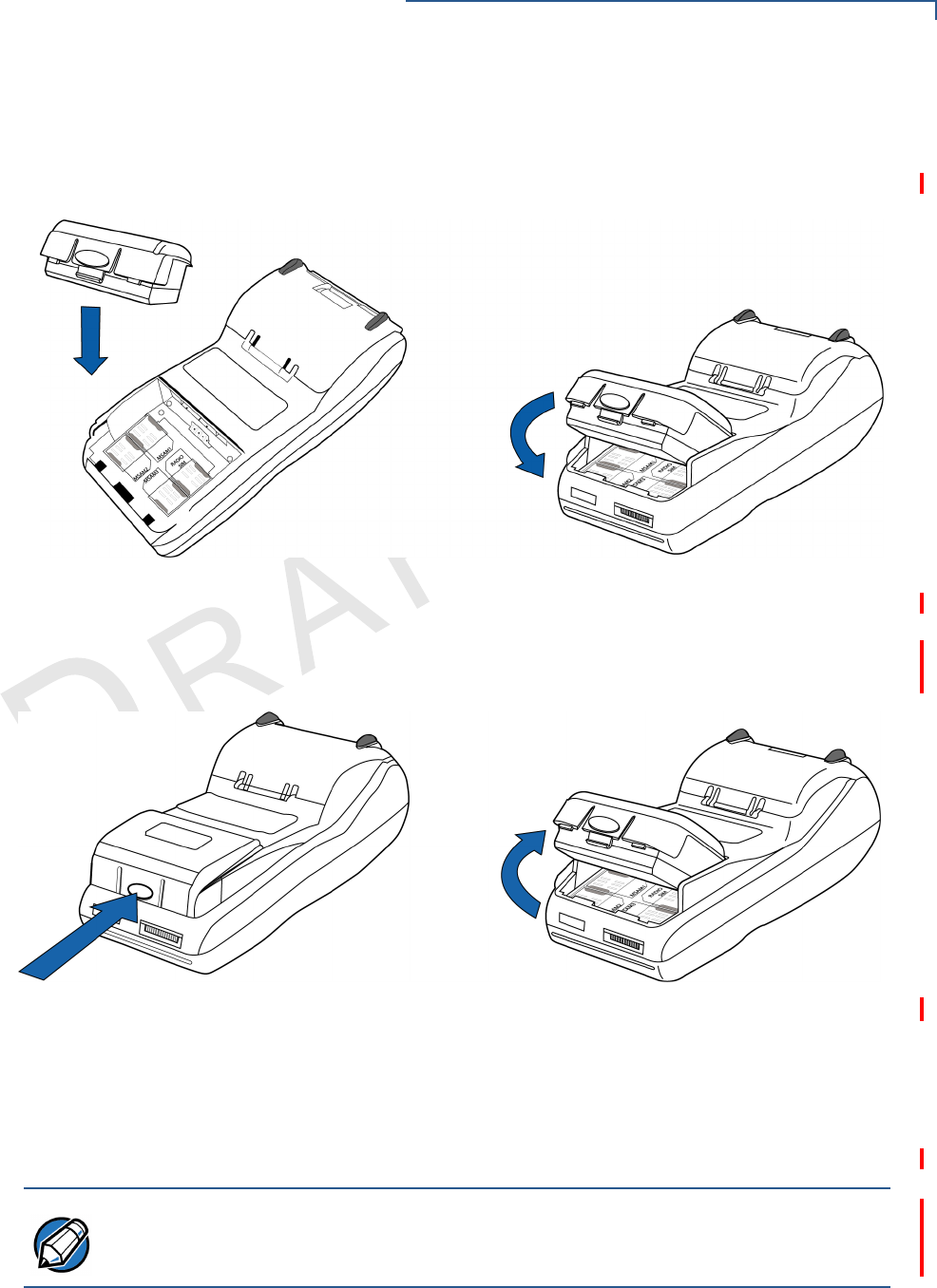
TERMINAL SETUP
Smart Battery
VX670 INSTALLATION GUIDE 29
TEMPLATE
R
EV
E
Installation
The Vx670 smart battery fits in a slot on the back of the Vx670 terminal, as shown
in Figure 16. The locking tab clicks when the battery is in place. The slot is keyed,
so that there is only one way to insert the battery.
Figure 16 Install the Smart Battery
Removal
To remove the Vx670 smart battery, press the locking tab at the top of the battery
and pull the smart battery from its slot.
Figure 17 Detaching the Smart Battery from the Vx670 Terminal
Charging
After unpacking your Vx670 terminal, install the battery and connect the power
pack to the unit for 6 hours.
It is also recommended that the smart battery receive a periodic full discharge. To
ensure a full discharge, use the unit until the battery is fully drained.
The smart battery has a safety circuit to protect the Li-ion cells from overcharging
and over-discharging. If the battery is over-discharged, the safety circuit shuts
down the battery. The battery must then be recharged to restore operation.
NOTE The Vx670 terminal’s smart battery is also charged when the terminal is in the
Base Station. For more information, see Place the Vx670 Terminal Onto the Base
Station.
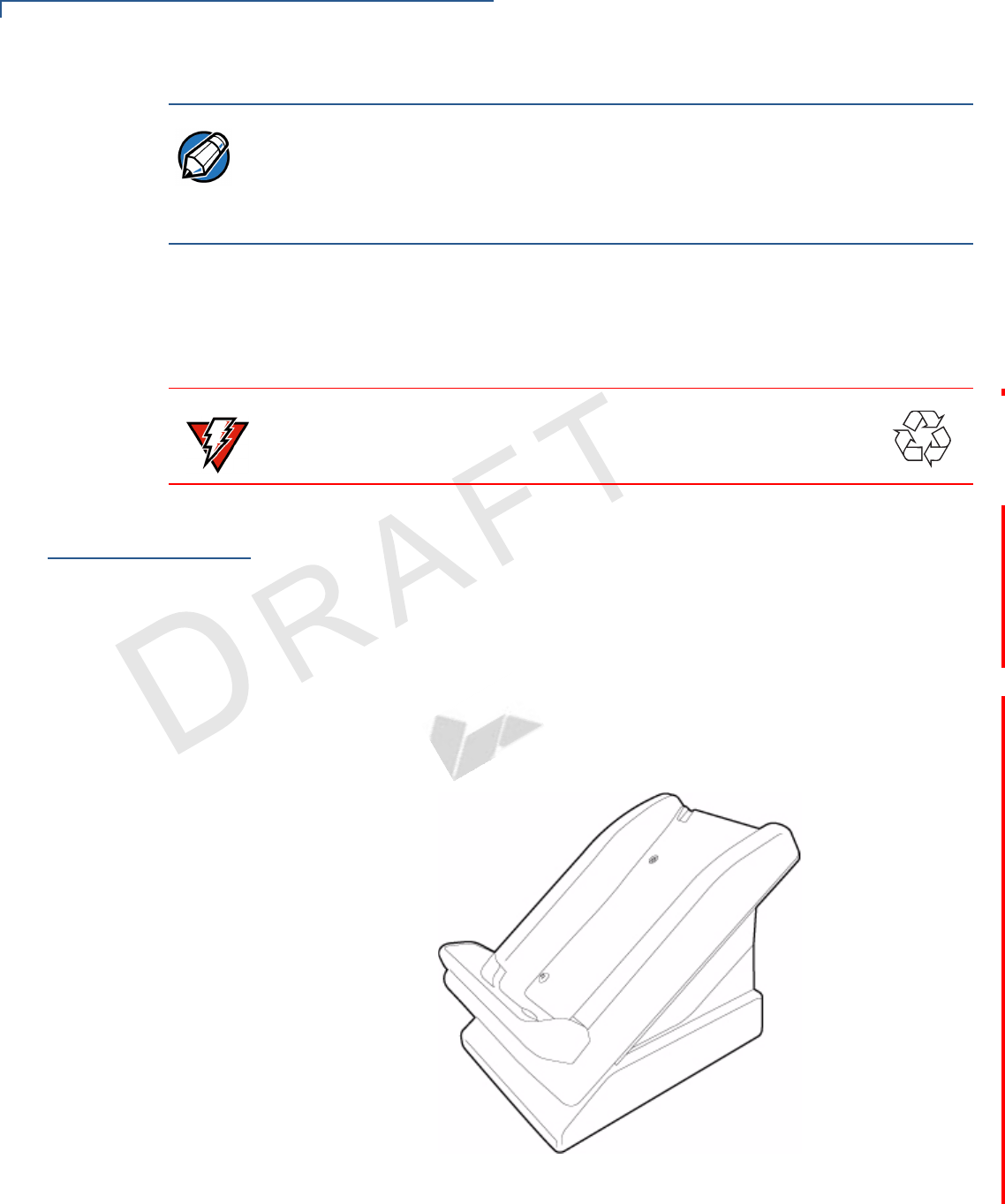
TERMINAL SETUP
The Vx670 Base Station
30 VX670 INSTALLATION GUIDE
TEMPLATE
R
EV
E
Battery Life
The Vx670 smart battery can be charged and discharged hundreds of times, but
will eventually wear out. When operating times are noticeably shorter than usual,
it is time to buy a new battery (see Accessories and Documentation for ordering
information).
The V
x
670 Base
Station
The primary purpose of the Base Station is to charge the terminal battery and
provide a docking station for the terminal after being used in pay-at-table
environments. The Base Station can be positioned on a countertop or mounted to
the wall (see).
There are two types of Base Station, the standard model and the full-featured
model.
Standard Base
Station
SThe standard Base Station can charge the Vx670 terminal. However, it does not
have any USB port and has a single LCD to indicate power status.
Figure 18 The Vx670 Standard Base Station
NOTE The Vx670 terminal automatically shuts off when the smart battery reaches the
critically low charge state. If this occurs, the smart battery must be recharged for
a minimum of 1/2 hour before it can power the terminal. It may take several
recharge attempts to reset the safety circuit when charging a smart battery that
has been discharged below this critical state.
WARNING Do not dispose of batteries in a fire. Li-ion batteries must be recycled
or disposed of properly. Do not dispose of Li-ion batteries in municipal
waste sites.
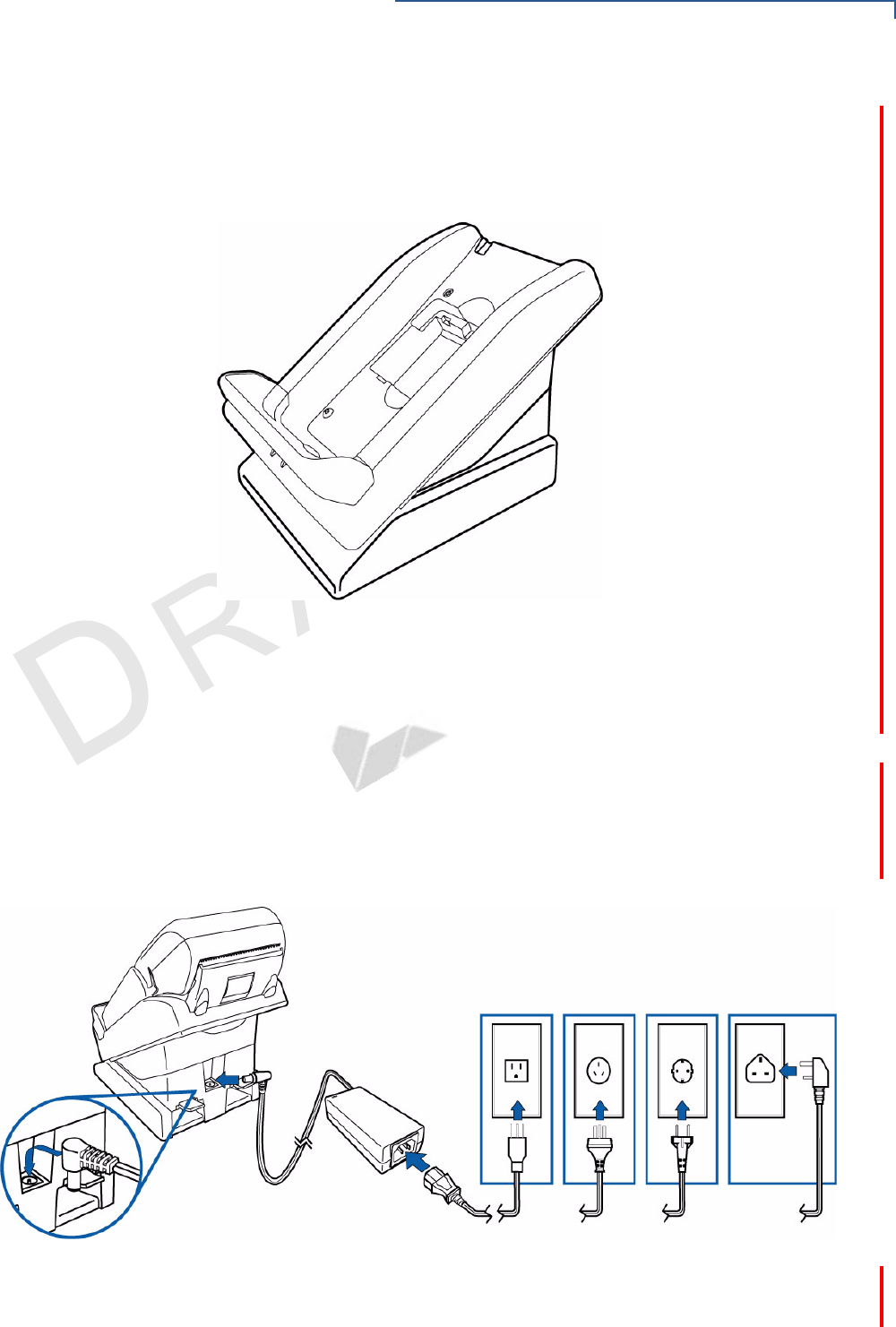
TERMINAL SETUP
The Vx670 Base Station
VX670 INSTALLATION GUIDE 31
TEMPLATE
R
EV
E
Full-featured Base
Station
The full-featured Base Station can charge the Vx670 terminal while charging an
extra battery pack. In addition, it has two USB ports for external dongles, together
with one LED for power indication and another LED for the charger status.
Figure 19 The Vx670 Full-Featured Base Station
For more information on charging the spare battery on the Full-Featured Base
Station and connecting external dongles to the USB ports, see Charge the Spare
Battery on the Base Station and Attach the USB Dongles to the Base Station.
Powering up the
Base Station
Use the procedure in this section to connect the Vx670 Base Station to a power
source.
1Insert the round barrel connector of the power pack into the power port at the
back of the Base Station.
2Insert the AC power cord into the power pack.
3Plug the AC power cord into a wall outlet or powered surge protector.
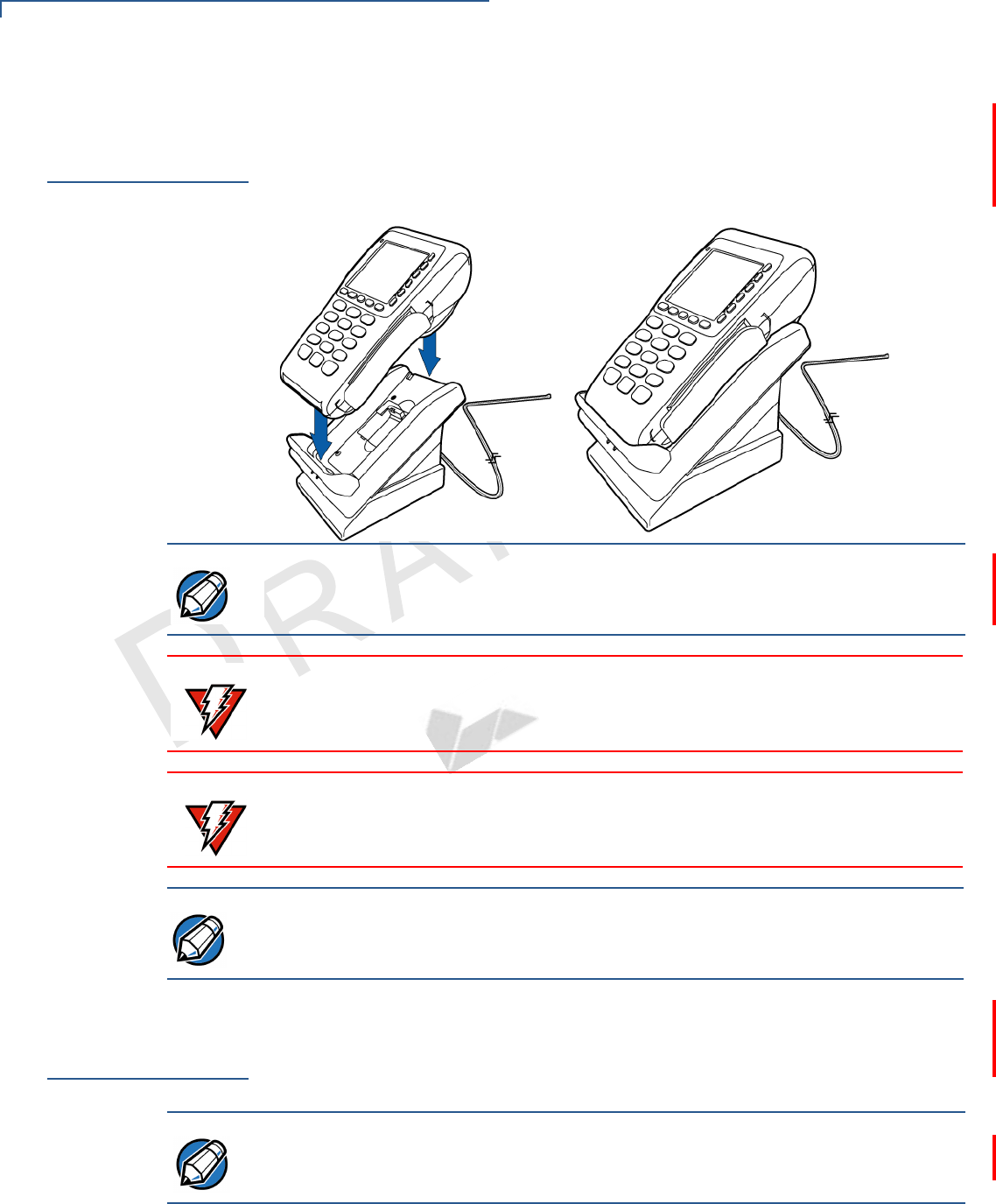
TERMINAL SETUP
Place the Vx670 Terminal Onto the Base Station
32 VX670 INSTALLATION GUIDE
TEMPLATE
R
EV
E
Place the V
x
670
Terminal Onto
the Base Station
The Vx670 terminal can be placed on the Base Station when not in use or to
charge the battery. External peripherals can also be attached to the terminal via
USB dongles while it is on the Base Station (see Attach the USB Dongles to the
Base Station).
Attach the USB
Dongles to the
Base Station
While the Vx670 terminal is resting on the Base Station, you can attach external
peripherals to the terminal using USB dongles, including modems and RS232
devices.
NOTE The Full-Featured Base Station can also charge a spare battery while it charges
the battery attached to the terminal (see Charge the Spare Battery on the Base
Station).
WARNING Do not plug the power pack into an outdoor outlet or operate the terminal
outdoors.
WARNING Disconnecting the power during a transaction may cause transaction data files
not yet stored in terminal memory to be lost.
NOTE To protect against possible damage caused by lightning strikes and electrical
surges, consider installing a power surge protector.
NOTE The full-featured Base Station has USB ports for two external dongles. The
standard Base Station does not have USB ports.
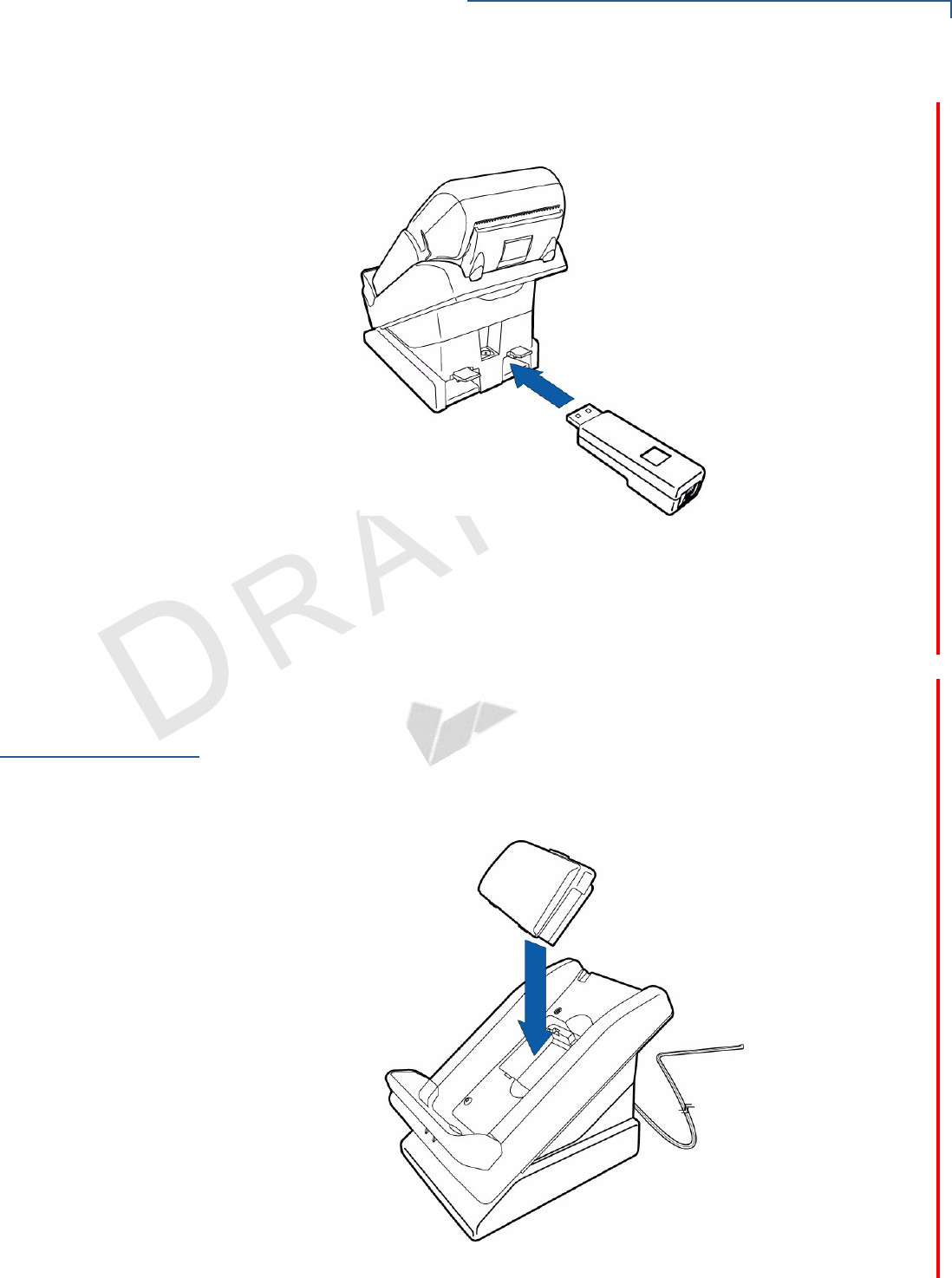
TERMINAL SETUP
Charge the Spare Battery on the Base Station
VX670 INSTALLATION GUIDE 33
TEMPLATE
R
EV
E
1Insert the USB dongle into the USB port located at the back of the Base
Station.
Figure 20 Insert External Dongle Into USB Port
2After inserting the external dongle into the USB port, place the Vx670 terminal
onto the Base Station (see Powering up the Base Station).
3Connect the peripheral to the external dongle.
Charge the
Spare Battery on
the Base Station
The Full-Featured Base Station can charge the Vx670 terminal while charging an
extra battery pack.
1Connect the Base Station to a power source (see Powering up the Base
Station)
2Place the spare battery pack onto the Base Station as shown in Figure 21.
Figure 21 Put Spare Battery Pack Into the Base Station
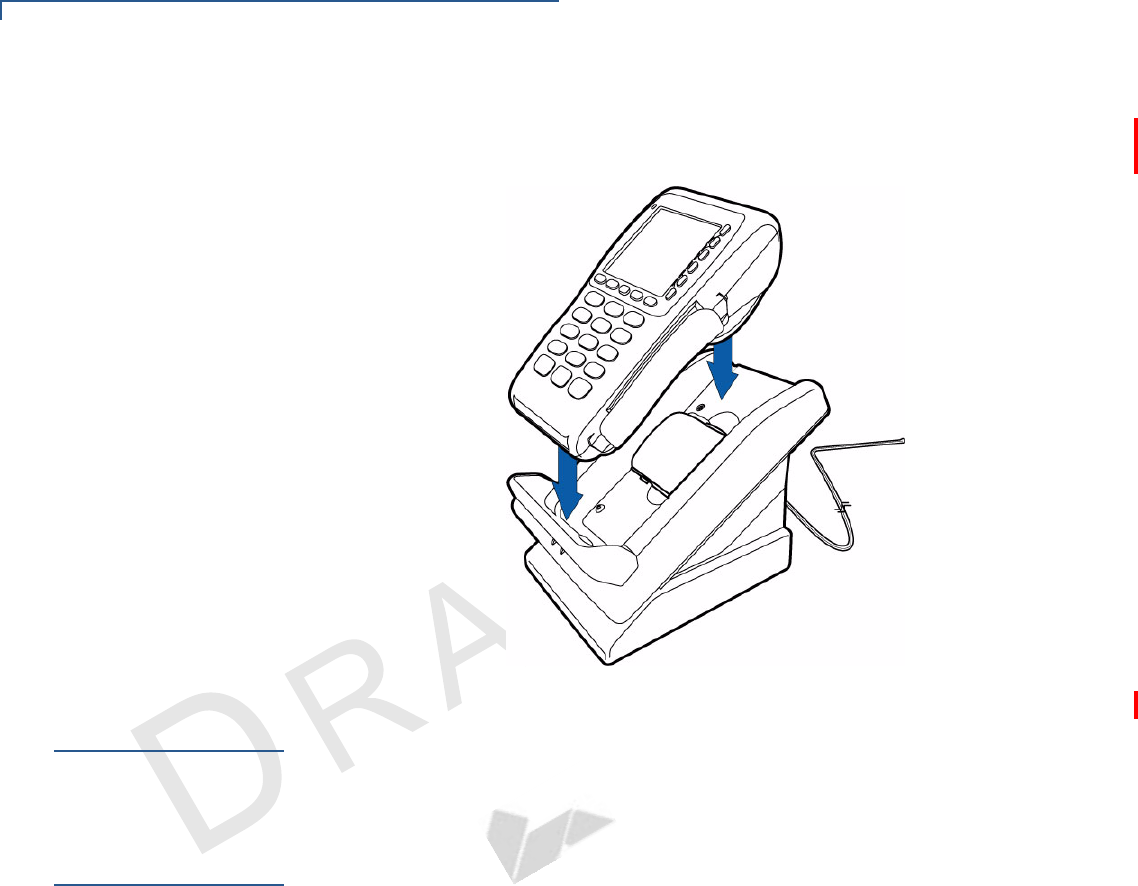
TERMINAL SETUP
Wireless Transactions
34 VX670 INSTALLATION GUIDE
TEMPLATE
R
EV
E
3Place the Vx670 terminal onto the Base Station to charge both the spare and
installed battery packs at the same time.
Wireless
Transactions
To conduct a wireless transaction:
•Ensure the terminal is in an optimal position for transmitting.
•Follow the on-screen instructions provided with your application.
Smart Card
Transaction
The smart card transaction procedure may vary from one application to another.
Verify the procedure with your application provider before performing a smart card
transaction.
To Conduct a Smart
Card Transaction
1Position a smart card with the contacts facing upward (see Figure 22).
2Insert the smart card into the smart card reader slot in a smooth, continuous
motion until it seats firmly.
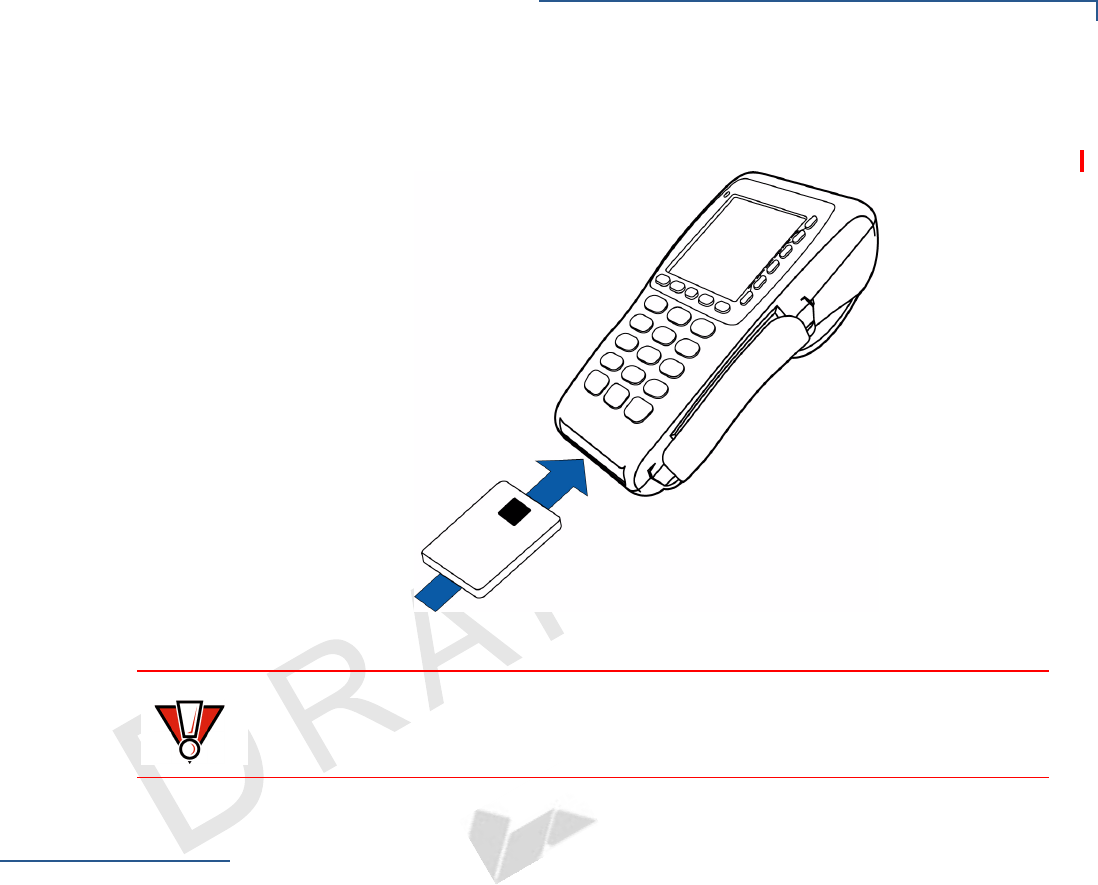
TERMINAL SETUP
Magnetic Card Reader Use
VX670 INSTALLATION GUIDE 35
TEMPLATE
R
EV
E
3Remove the card only when the application indicates the transaction is
complete.
Figure 22 Inserting a Smart Card
Magnetic Card
Reader Use
The Vx670 terminal supports credit/debit card transactions.
To Conduct a Credit/
Debit Card
Transaction
1Position a magnetic card with the stripe in the card reader and facing inward,
toward the keypad.
2To ensure a proper read of the magnetic swipe card, the user should insert the
magnetic card from the top of the unit, as shown in Figure 23.
CAUTION Leave the smart card in the card reader until the transaction is complete.
Premature card removal will invalidate the transaction.
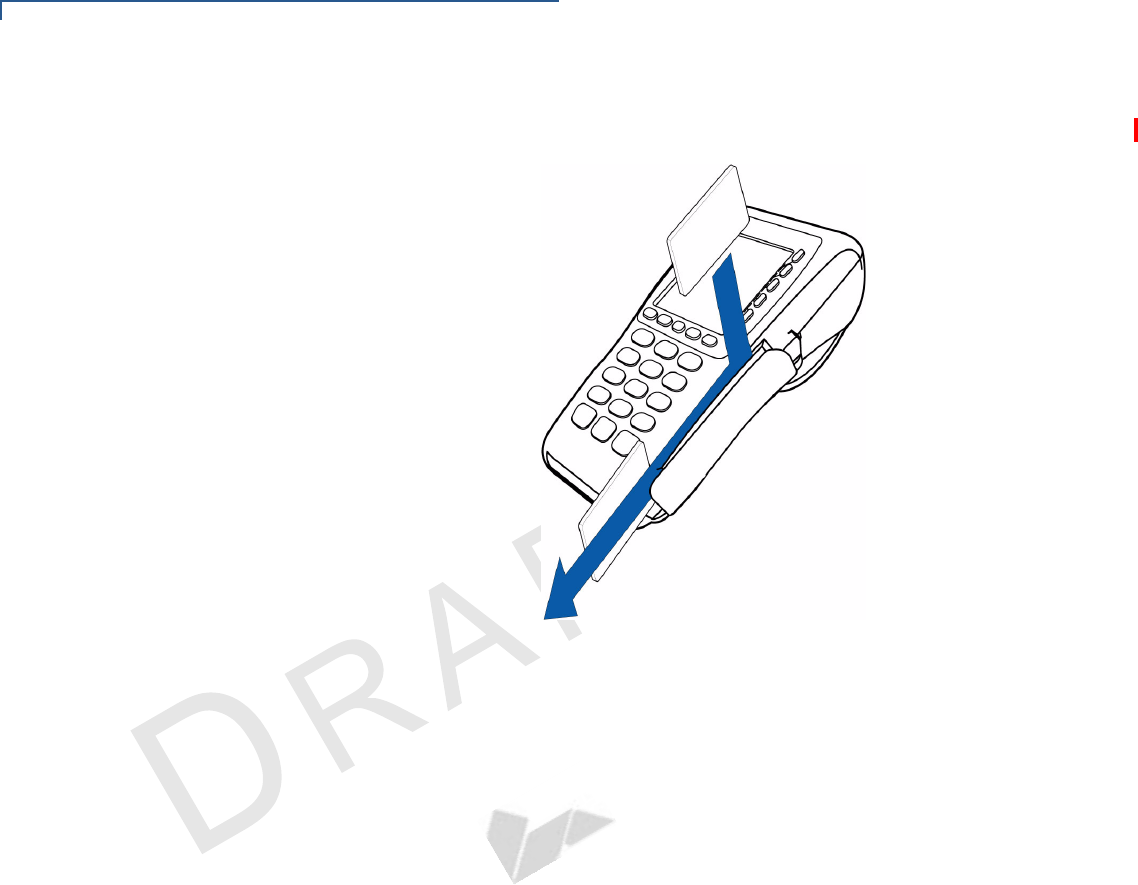
TERMINAL SETUP
Magnetic Card Reader Use
36 VX670 INSTALLATION GUIDE
TEMPLATE
R
EV
E
3Swipe the card through the magnetic card reader.
Figure 23 Using the Magnetic Card Reader

TEMPLATE
R
EV
E
VX670 INSTALLATION GUIDE 37
CHAPTER 3
Specifications
This chapter discusses power requirements, dimensions, and other specifications
of the Vx670 terminal.
Power
Vx670 terminal: 9 V DC; 4.0 A
DC Power Pack
UL, ITE listed, Class 2 power supply:
aInput rated: 100 - 240V AC, 50/60 Hz
bOutput rated: 8.6 - 9.4V DC 4.0 A
Barrel connector polarity:
Temperature
•Operating temperature: 0°
to 40°
C (32°
to 104°
F)
•Storage temperature: -30°
to + 60°
C (-22°
to 140°
F)
•Relative humidity: 5% to 90%; no condensation
V
x
670 External
Dimensions
For Vx670 Terminals:
•Length: <180 mm (8.2 in)
•Width: <78 mm (4.0 in)
•Depth: TBD mm (2.8 in)
(need more accurate info for external dimensions)
Base Station
Specifications
(need more info for this section)

SPECIFICATIONS
Base Station Specifications
38 VX670 INSTALLATION GUIDE
TEMPLATE
R
EV
E

TEMPLATE
R
EV
E
VX670 INSTALLATION GUIDE 39
CHAPTER 4
Maintenance
The Vx670 terminal has no user-maintainable parts.
(need more info for this section. is the base station user maintainable? what about
the USB dongles and the Handy-Link connector?)
Clean the
Terminal
To clean the terminal, use a clean cloth slightly dampened with water and a drop
or two of mild soap. For stubborn stains, use alcohol or an alcohol-based cleaner.
Terminal
Contacts
Gently swab the contacts with alcohol or contact cleaner to remove the dirt. It is
important that the exposed contacts of the Vx670 battery stay clean and unbent.
Smart Card
Reader
Do not attempt to clean the smart card reader. Doing so may void any warranty.
For smart card reader service, contact your VeriFone distributor or service
provider.
CAUTION Never use thinner, trichloroethylene, or ketone-based solvents – they may cause
deterioration of plastic or rubber parts.
Do not spray cleaners or other solutions directly onto the keypad or terminal
display.
CAUTION Avoid touching the contacts in the raised area in the center of the Vx670 battery
and the recessed area on the terminal. Finger oils tarnish contacts, causing bad
connections. When operating on battery power and experiencing a high
occurrence of bad or incomplete data transfers, clean the contacts.

MAINTENANCE
Smart Card Reader
40 VX670 INSTALLATION GUIDE
TEMPLATE
R
EV
E

TEMPLATE
R
EV
E
VX670 INSTALLATION GUIDE 41
CHAPTER 5
VeriFone Service and Support
For Vx670 terminal problems, contact your local VeriFone representative or
service provider.
For Vx670 product service and repair information:
•USA – VeriFone Service and Support Group, 1-800-VeriFone (837-4366),
Monday - Friday, 8 A.M. - 8 P.M., Eastern time
•International – Contact your VeriFone representative
Return a
Terminal or
Smart Battery
for Service
Before returning a Vx670 terminal, smart battery, or sled module to VeriFone, you
must obtain an MRA number. The following procedure describes how to return
one or more Vx670 terminals, smart batteries, or sled modules for repair or
replacement (U.S. customers only).
To Return a Terminal
for Service
1Get the following information from the printed labels on the bottom of each
Vx670 terminal, smart battery, or sled module to be returned:
•Product ID, including the model and part number. For example, “Vx670”
and “Pxxx- xxx-xx,” “Mxxx-xx-xx-xxx,” or “2xxxx-xx”
•Serial number (S/N xxx-xxx-xxx)
2Obtain the MRA number(s) by completing one of the following:
aCall VeriFone toll-free within the United States at 1-800-VeriFone and
follow the automated menu options.
•Select the MRA option from the automated message. The MRA
department is open Monday to Friday, 8 A.M.–8 P.M., Eastern Time.
•Give the MRA representative the information you gathered in Step 1.
If the list of serial numbers is long, you can fax the list, along with the
information gathered in Step 1, to the MRA department at 727-953-
4172 (U.S.).
bAddress a fax to “VeriFone MRA Dept.” with the model and part number(s)
•Include a telephone number where you can be reached and your fax
number.
NOTE International customers are advised to contact their local VeriFone representative
for assistance regarding service, return, or replacement of terminals or batteries.

VERIFONE SERVICE AND SUPPORT
Accessories and Documentation
42 VX670 INSTALLATION GUIDE
TEMPLATE
R
EV
E
cComplete the Inquiry Contact Form at http://www.verifone.com/aboutus/
contact/contact_form.cfm.
•Address the Subject box with to “VeriFone MRA Dept.”
•Reference the model and part number in the Note box.
3Describe the problem(s).
4Provide the shipping address where the repaired or replacement unit must be
returned.
5Keep a record of the following items:
•Assigned MRA number(s).
•VeriFone serial number assigned to the Vx670 terminal, smart battery, or
sled module you are returning for service or repair (terminal serial
numbers are located on the bottom of the unit.
•Shipping documentation, such as air bill numbers used to trace the
shipment.
•Model(s) returned (model numbers are located on the VeriFone label on
the bottom of the Vx670 terminal).
Accessories
and
Documentation
VeriFone produces the following accessories and documentation for the
Vx670 terminal. When ordering, please refer to the part number in the left column.
•VeriFone online store at www.store.verifone.com
•USA – VeriFone Customer Development Center, 800-VeriFone (837-4366),
Monday - Friday, 7 A.M. - 8 P.M., Eastern time
•International – Contact your VeriFone representative
Power Pack
Contact your local VeriFone distributor to determine which power pack or
power cord fits your needs.
CPS10936-3A DC power pack (universal)
21973-01 AC power cord (US)
(need updated info for this section)
Thermal Printer
Paper
CRM0039-01 CRM0039 in 30-roll bulk package
CRM0040 High-grade thermal printer paper, 57 mm (2.24-inch) width,
25-meter (82-feet) length; single roll; Available in 20-roll or
50-roll bulk packages
NOTE One MRA number must be issued for each Vx670 terminal you return to VeriFone,
even if you are returning several of the same model.

VERIFONE SERVICE AND SUPPORT
Accessories and Documentation
VX670 INSTALLATION GUIDE 43
TEMPLATE
R
EV
E
(need updated info for this section)
VeriFone Cleaning
Kit
02746-01 Cleaning Kit
(need updated info for this section)
Telephone Line
Cord
00124-17 2.1-meter (7-foot) telephone line cord, black, with
modular RJ11-type connectors
(need updated info for this section)
Swivel Stand
23050-01 Vx510 Swivel Stand
(need updated info for this section)
Documentation
For Vx670 Terminals:
24003 Vx670 Installation Guide
23217 Vx670 Reference Manual
24004 Verix V Operating System Programmer’s Manual
23231 Verix V Tools Programmer’s Manual

VERIFONE SERVICE AND SUPPORT
Accessories and Documentation
44 VX670 INSTALLATION GUIDE
TEMPLATE
R
EV
E

TEMPLATE
R
EV
E
VX670 INSTALLATION GUIDE 45
CHAPTER 6
Troubleshooting
Guidelines
The troubleshooting guidelines provided in the following section are included to
assist you to successfully install and configure your Vx670 terminal. If you have
problems operating your Vx670 terminal, please read through these
troubleshooting examples.
If the problem persists even after performing the outlined guidelines or if the
problem is not described below, contact your local VeriFone representative for
assistance. Typical examples of malfunction you may encounter while operating
your Vx670 terminal and steps you can take to resolve them are listed.
Terminal Does
Not Start
•Ensure that the smart battery charge state is not below the critically low level.
•Recharge or replace the smart battery.
•Ensure that you pressed the ENTER/ON key for approximately 3 seconds,
until the unit lits up.
Terminal Display
Does not Show
Correct/Readable
Info
•Recharge or replace the battery.
•Connect the Vx670 terminal into a known-good power supply (if you have one)
to see if this clears the problem.
If the problem persists, contact your local VeriFone representative for assistance.
NOTE The Vx670 terminal comes equipped with tamper-evident labels. The
Vx670 contains no user serviceable parts. Do not, under any circumstance,
attempt to disassemble the terminal. Perform only those adjustments or repairs
specified in this guide. For all other services, contact your local VeriFone service
provider. Service conducted by parties other than authorized VeriFone
representatives may void any warranty.
CAUTION Use only a VeriFone-supplied power pack. Using an incorrectly rated power
supply may damage the terminal or cause it not to work as specified. Before
troubleshooting, ensure that the power supply being used to power the terminal
matches the requirements specified on the bottom of the terminal. (See Chapter
3, Specifications, for detailed power supply specifications.) Obtain the
appropriately rated power supply before continuing with troubleshooting.

TROUBLESHOOTING GUIDELINES
Smart Battery Will Not Charge
46 VX670 INSTALLATION GUIDE
TEMPLATE
R
EV
E
Smart Battery
Will Not Charge
The Vx670 smart battery must initially receive a full charge to calibrate its full
charge capacity.
Spare Battery in
Base Station Will
Not Charge
(Need info for this section)
Blank Display
When the Vx670 terminal display screen does not show correct or clearly readable
information:
•Check terminal power connection.
•Remove and reapply power to the terminal.
•Check all cable connections and verify that the telephone line is properly
connected.
•If the problem persists, contact your local VeriFone service provider.
Terminal Does
Not Dial Out
If the terminal does not dial out:
•Check the telephone line connections.
•Check that the telephone line is working by plugging it into a working
telephone and listening for a dial tone.
•Replace the telephone cable that connects the terminal with a cable you know
is working correctly.
•If the problem persists, contact your local VeriFone service provider.
Printer Does Not
Print
If the printer does not work properly:
•Check battery status or terminal power connection. The printer will not print if
there is an insufficient charge remaining in the battery to complete the print
operation.
•Check if the printer is out of paper and that the roll is properly installed. Open
the paper roll cover and install a new roll of printer paper or ensure that the roll
is feeding from the bottom.
NOTE Allow the Vx670 terminal to remain connected to the power pack for 6 hours to
ensure the battery receives a full charge.
Conserve battery power by turning the Vx670 terminal off when not in use. If the
terminal will not be used for several days, remove the battery from the terminal as
it continues to discharge even when the terminal is turned off.
NOTE The Vx670 terminal automatically shuts off when the smart battery reaches the
critically low charge state. If this occurs, the smart battery must recharge a
minimum of 1/2 hour before it can power the terminal. It may take several
recharge attempts to reset the safety circuit when charging a smart battery that
has been discharged below this critical state.

TROUBLESHOOTING GUIDELINES
Printer Paper Jam
VX670 INSTALLATION GUIDE 47
TEMPLATE
R
EV
E
•Verify that the printer roller and paper roll dust cover are properly installed.
•If the problem persists, contact your VeriFone distributor or service provider.
Printer Paper
Jam
If paper jams inside the printer:
•Press the button on the side of the terminal to unlatch the paper roll cover,
then open the cover.
•Remove the damaged paper from the paper roll and clear the feed
mechanism.
•Install a roll of printer paper, as described in Install the Paper Roll.
•If the problem persists, it may be due to poor paper quality. Install a new
roll of higher-quality paper.
Peripheral
Device Does Not
Work
If any peripheral device (PINpad or smart card reader) does not work properly:
•Check the power cord connection to the peripheral device.
•Check that the device connected to the proper port has power and is
functioning properly. If possible, perform a self-test on the device in question.
•The cable connecting the optional device to the Vx670 terminal serial port may
be defective. Try a different serial cable. See Connect the Smart Card Reader
(Optional).
•If the problem persists, contact your local VeriFone representative.
Keypad Does
Not Respond
If the keypad does not respond properly:
•Check the terminal display. If it displays the wrong character or nothing at all
when you press a key, follow the steps outlined in Transactions Fail To
Process.
•If pressing a function key does not perform the expected action, refer to the
user documentation for that application to ensure you are entering data
correctly.
•If the problem persists, contact your local VeriFone representative.
Transactions
Fail To Process
There are several reasons why the terminal may not be processing transactions.
Use the following steps to troubleshoot failures.
Check the Magnetic Card Reader
•Perform a test transaction using one or more different magnetic stripe cards to
ensure the problem is not a defective card.
WARNING Poor-quality paper may jam the printer. To order high-quality VeriFone paper,
refer to Accessories and Documentation.

TROUBLESHOOTING GUIDELINES
Transactions Fail To Process
48 VX670 INSTALLATION GUIDE
TEMPLATE
R
EV
E
•Ensure that you are swiping cards properly. With the Vx670 card reader, the
black magnetic stripe on the card should face down and inward, toward the
keypad and must be inserted from the top of the terminal (see Figure 23).
•Process a transaction manually, using the keypad instead of the card reader. If
the manual transaction works, the problem may be a defective card reader.
•Contact your VeriFone distributor or service provider.
•If the manual transaction does not work, proceed to Check the Telephone
Line.
Check the Smart Card Reader
•Perform a test transaction using several different smart cards to ensure the
problem is not a defective card.
•Ensure that the card is inserted correctly and that the card is not removed
prematurely.
•Ensure the MSAM cards are properly inserted in the cardholders and that the
cardholders are properly secured (see Install/Replace MSAM Cards).
•Contact your VeriFone distributor or service provider.
•If the manual transaction does not process, proceed to Check the Telephone
Line.
Check the Telephone Line
•Disconnect the telephone line from the Vx670 terminal and connect it to a
working telephone to check for a dial tone. If there is no dial tone, replace the
telephone cable.
•If the problem appears to be with the telephone line, check with the party you
are trying to call to see if their system is operational. If they are not
experiencing difficulties with their line, contact the telephone company and
have your line checked.
•If the telephone line works, contact your local VeriFone representative for
assistance.

VX670 INSTALLATION GUIDE 49
TEMPLATE
R
EV
E
INDEX
A
accessories 42
documentation 43
ordering 43
power packs 42
swivel stand 43
telephone line cord 43
thermal printer paper 42
VeriFone cleaning kit 43
B
Base Station 30
batteries
extending the battery life 30
See also smart battery
C
cable adapters 17
cleaning kit 43
connection ports 17
serial 17
USB device 18
USB host 18
contact VeriFone 41
D
dial out problems
troubleshooting 46
displays
troubleshooting 45, 46
documentation 42
acronym definitions 6
conventions 6
ordering 43
E
electrical considerations 14, 23
electrostatic discharges 23
prevention 23
environmental factors 14
F
Full-Featured Base Station 31
H
Handy-Link connector 17
I
installation 9
connecting a PINpad to Vx670 25
connecting a smart card reader to Vx670 25
connecting optional device(s) 25
connecting the terminal power pack 26
connecting the terminal to a telephone line 19
MSAM cardholders 23
MSAM cards 23
terminal location 13
unpacking the shipping carton 14
using the magnetic card reader 35
K
keypads
troubleshooting 47
M
magnetic card readers
using 35
maintenance
cleaning the terminal 39
cleaning the terminal contacts 39
returning a battery for repair or replacement 41
returning a terminal for repair or replacement 41
MSAM cardholders 23
MSAM cards 23
O
optional devices
connecting 25
P
paper jams
troubleshooting 47

INDEX
S
50 VX670 INSTALLATION GUIDE
TEMPLATE
R
EV
E
paper rolls
for thermal printers 20, 47
installation 20
peripherals
troubleshooting 47
power packs
AC version 42
connecting 26
DC version 42
ordering 42
printer paper
ordering 42
printers
troubleshooting 46
S
service
returning a battery for repair or replacement 41
returning a terminal for repair or replacement 41
SIM cards
for GSM models 24
smart battery 30
battery life 30
charging 29
conserving power 28
disposal 30
features 28
installation 29
recharging 30
removal 29
troubleshooting 46
spare batteries
charging on the Full-Featured Base Station 33
specifications
DC power pack 37
power 37
temperature 37
Standard Base Station 30
T
technical support
contacting VeriFone 41
returning a battery for repair or replacement 41
returning a terminal for repair or replacement 41
telephone line connections 19
telephone line cords
ordering 43
terminal features
general 15
terminals
accessories 42
benefits 10
cleaning 39
documentation 42
electrical considerations 14
environmental factors 14
features 15
repair 41
replacement 41
service and support 41
troubleshooting 45, 46
thermal printer paper
storage 20
thermal printers
about the thermal printer paper 20, 47
paper jams 47
troubleshooting 46
transactions
smart cards 34
wireless 34
troubleshooting
batteries 46
displays 45, 46
guidelines 45
keypads 47
peripherals 47
printers 46
terminal transactions 47
terminals 45, 46
U
USB connections 18
USB dongles
modem 19
serial 19
V
VeriCentre Appliance Management Suite
simultaneous downloads 10
Vx670
multi-application capability 11

INDEX
W
52 VX670 INSTALLATION GUIDE
TEMPLATE
R
EV
E
FCC Regulations:
zThis device complies with part 15 of the FCC Rules. Operation is subject to the
following two conditions: (1) This device may not cause harmful interference, and (2)
this device must accept any interference received, including interference that may
cause undesired operation.
zThis device has been tested and found to comply with the limits for a Class B digital
device, pursuant to Part 15 of the FCC Rules. These limits are designed to provide
reasonable protection against harmful interference in a residential installation. This
equipment generates, uses and can radiated radio frequency energy and, if not
installed and used in accordance with the instructions, may cause harmful interference
to radio communications. However, there is no guarantee that interference will not
occur in a particular installation If this equipment does cause harmful interference to
radio or television reception, which can be determined by turning the equipment off
and on, the user is encouraged to try to correct the interference by one or more of the
following measures:
-Reorient or relocate the receiving antenna.
-Increase the separation between the equipment and receiver.
-Connect the equipment into an outlet on a circuit different from that to which the
receiver is connected.
-Consult the dealer or an experienced radio/TV technician for help.
Changes or modifications not expressly approved by the party responsible for
compliance could void the user‘s authority to operate the equipment.
zThe antenna(s) must not be co-located or operating in conjunction with any other
antenna or transmitter.

4RF Exposure Information (SAR)
This device meets the government’s requirements for exposure to radio waves.
This device is designed and manufactured not to exceed the emission limits for
exposure to radio frequency (RF) energy set by the Federal Communications
Commission of the U.S. Government.
The exposure standard for wireless devices employs a unit of measurement known as
the Specific Absorption Rate, or SAR. The SAR limit set by the FCC is 1.6W/kg.
*Tests for SAR are conducted using standard operating positions accepted by the FCC
with the device transmitting at its highest certified power level in all tested frequency
bands. Although the SAR is determined at the highest certified power level, the
actual SAR level of the device while operating can be well below the maximum value.
This is because the device is designed to operate at multiple power levels so as to use
only the poser required to reach the network. In general, the closer you are to a
wireless base station antenna, the lower the power output.
The highest SAR value for the device as reported to the FCC when tested for worn on
the body, as described in this user guide, is 0.211 W/kg for GSM Body SAR and
0.254 W/kg for PCS Body SAR. (Body-worn measurements differ among device
models, depending upon available enhancements and FCC requirements.)
While there may be differences between the SAR levels of various devices and at
various positions, they all meet the government requirement.
The FCC has granted an Equipment Authorization for this device with all reported
SAR levels evaluated as in compliance with the FCC RF exposure guidelines. SAR
information on this device is on file with the FCC and can be found under the Display
Grant section of http://www.fcc.gov/oet/fccid after searching on FCC ID:
B32VX670GPRS.
For body worn operation, this device has been tested and meets the FCC RF exposure
guidelines for use with an accessory that contains no metal and the positions the
handset a minimum of 1.5 cm from the body. Use of other enhancements may not
ensure compliance with FCC RF exposure guidelines.

